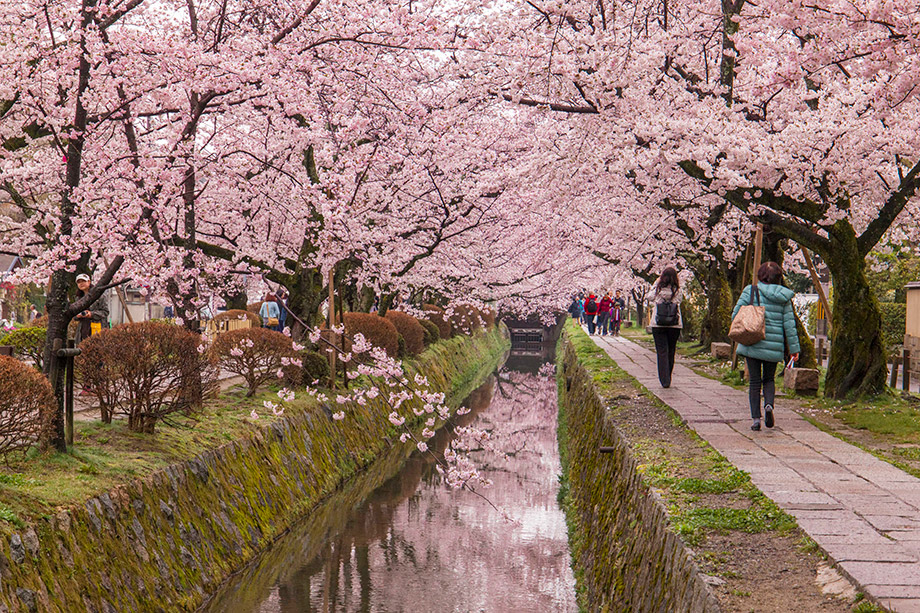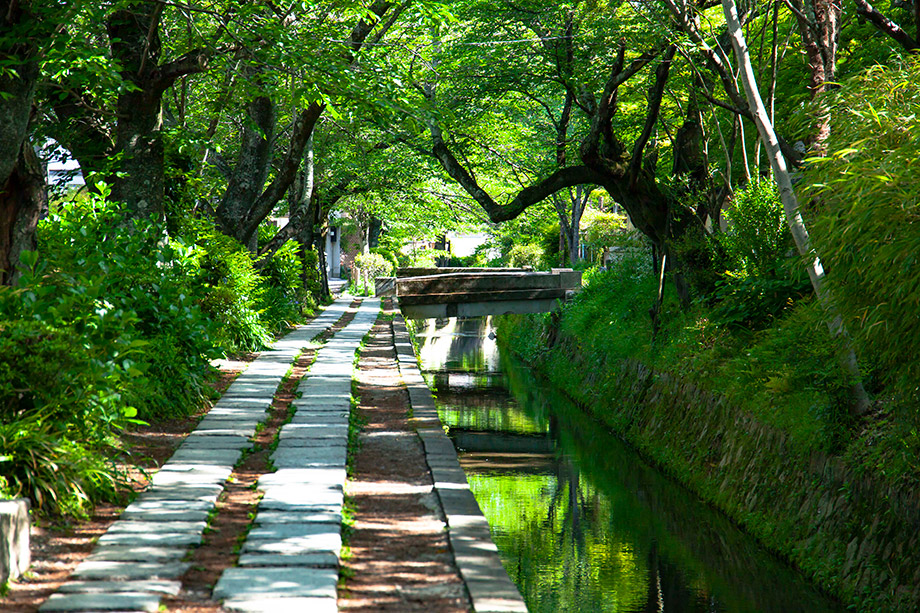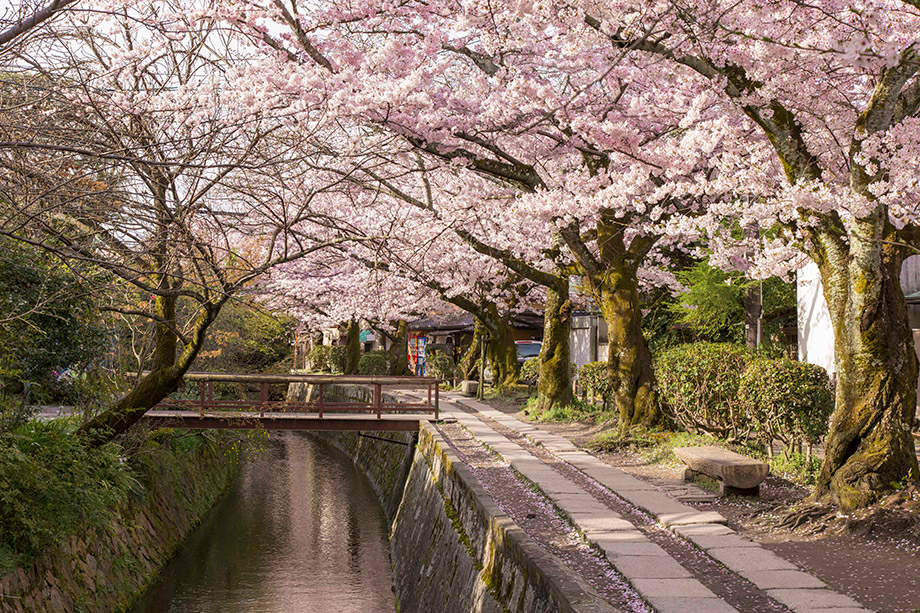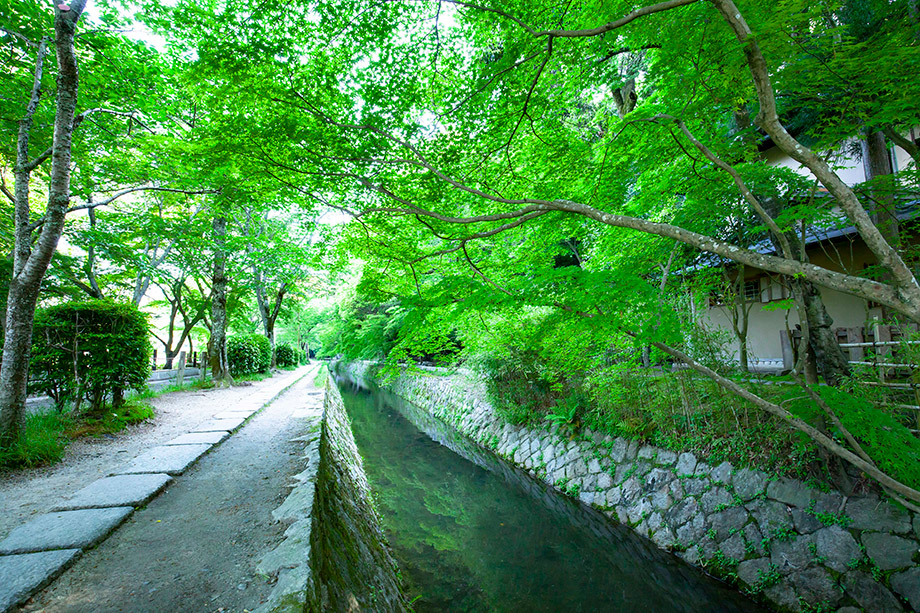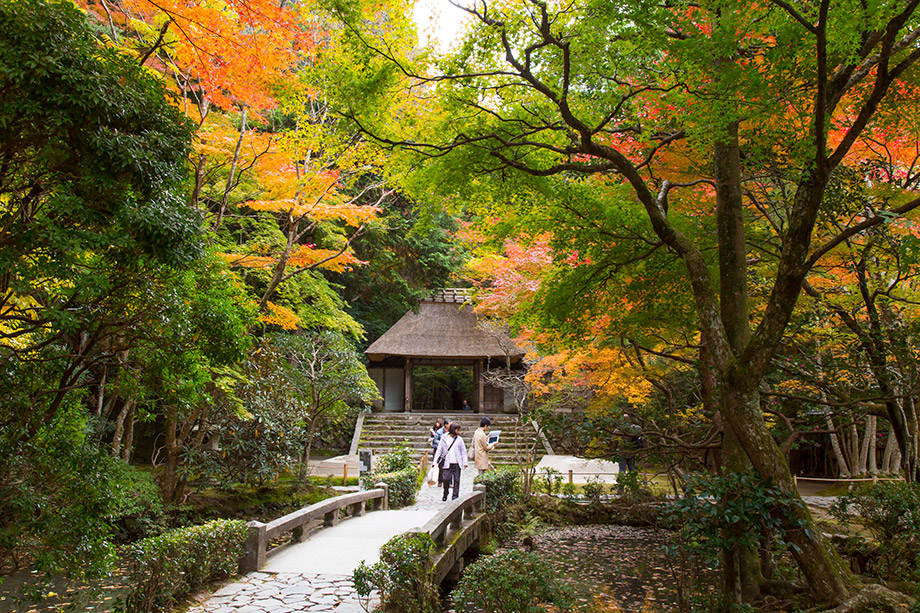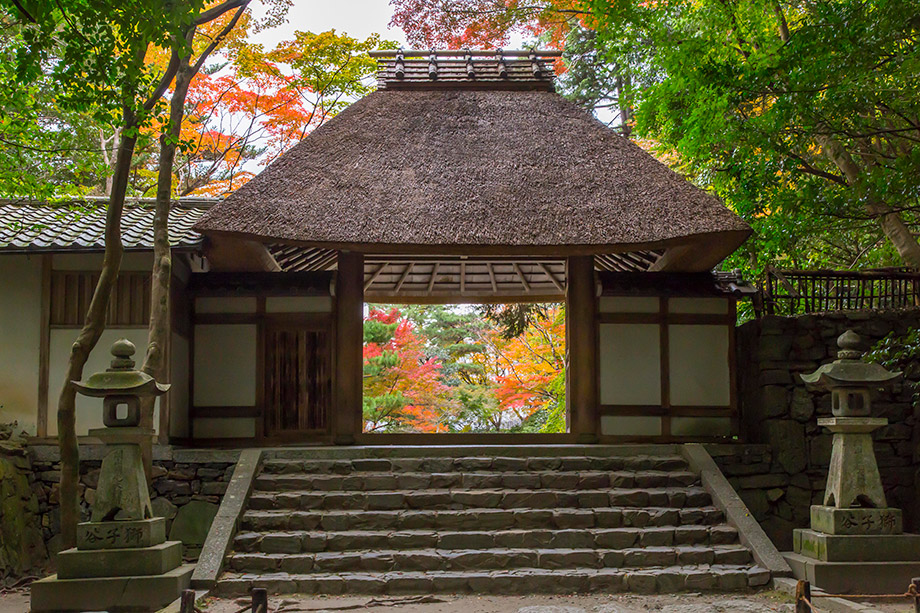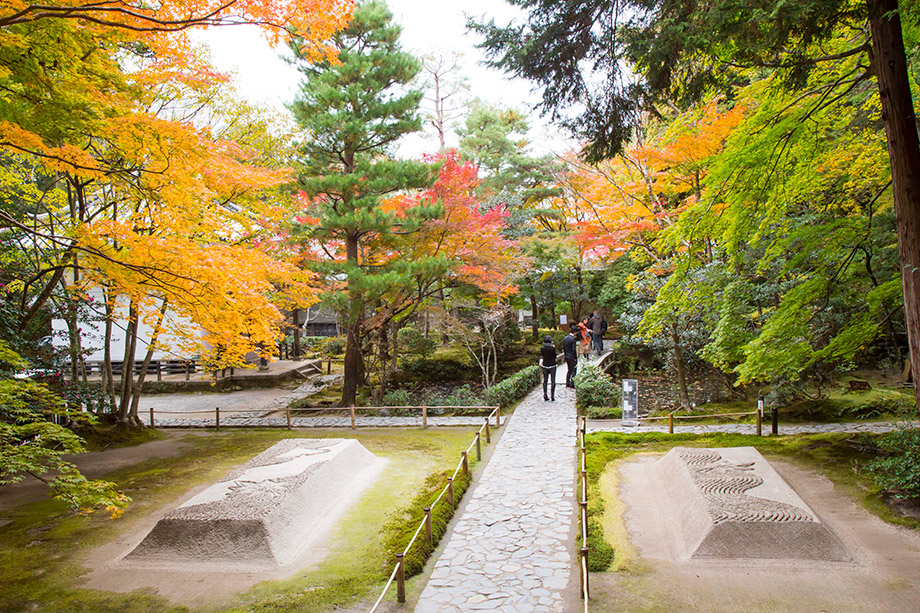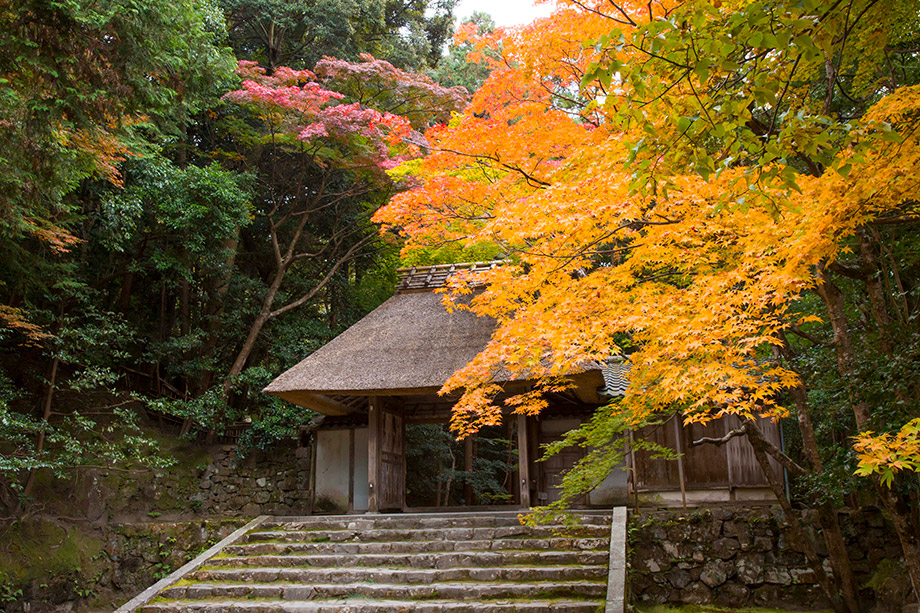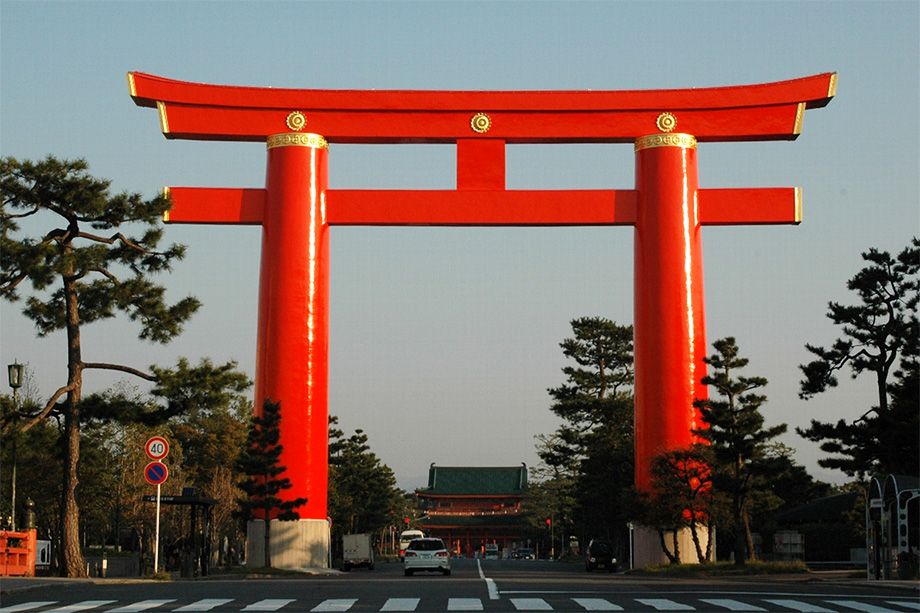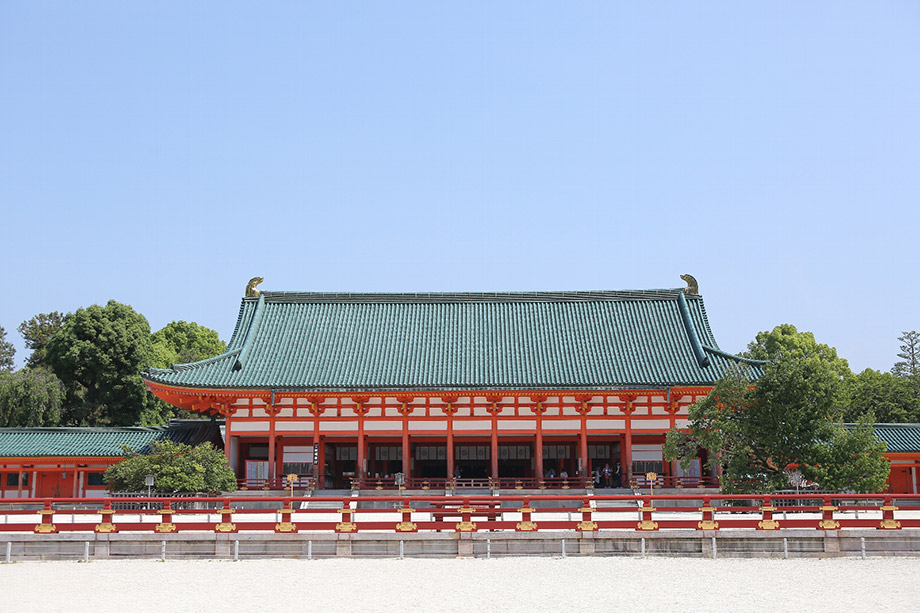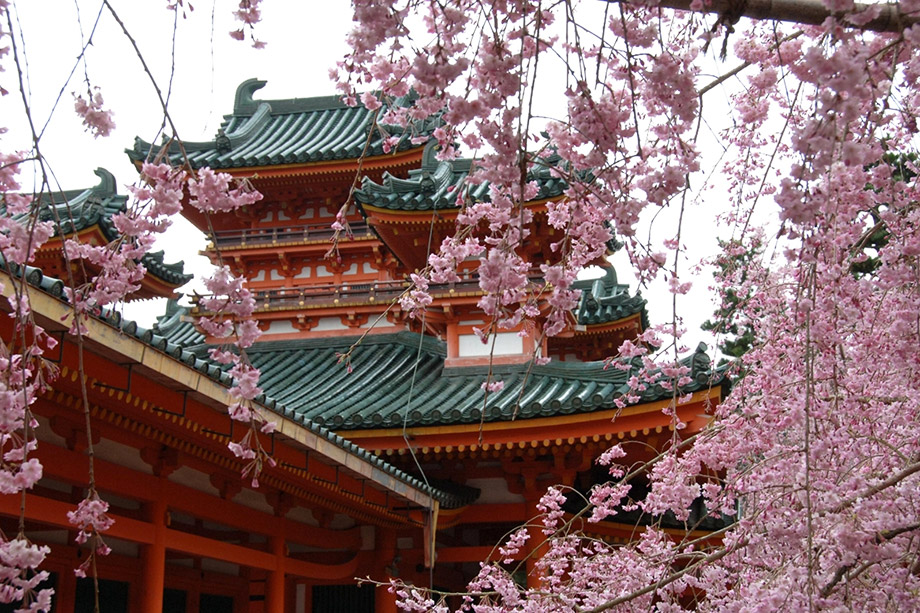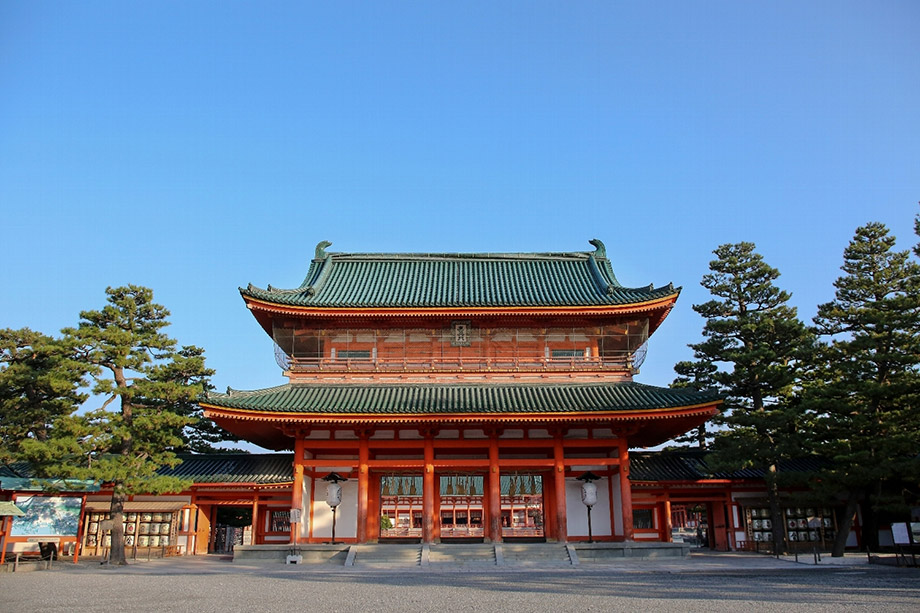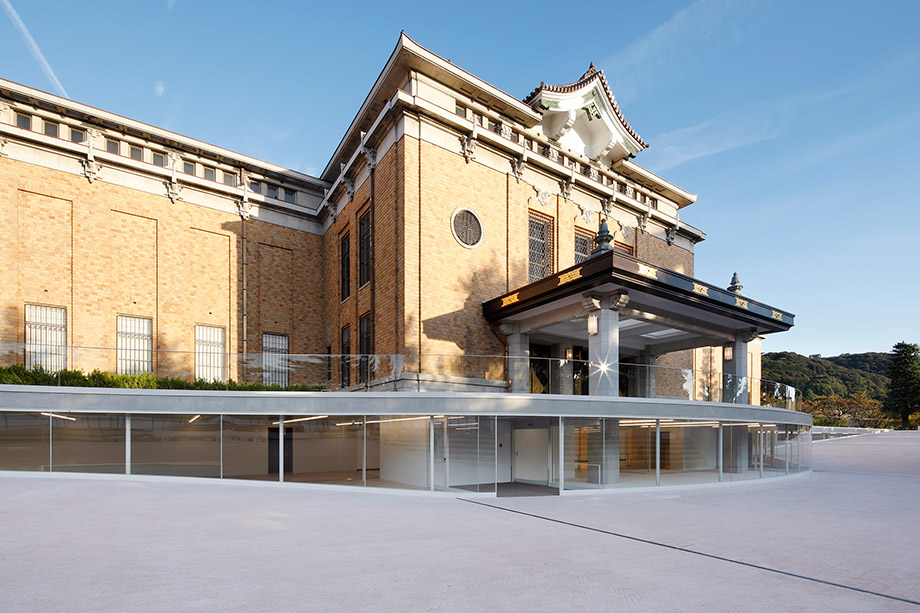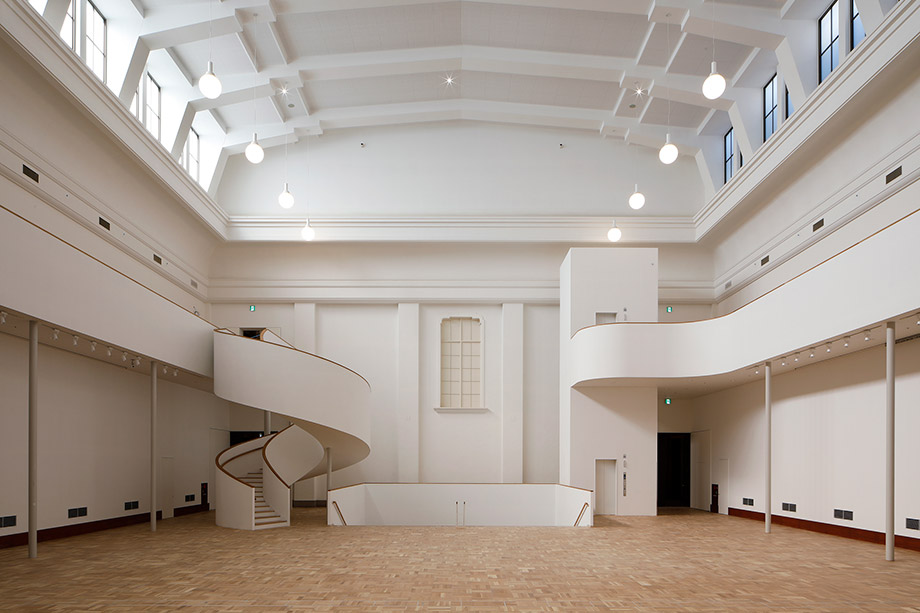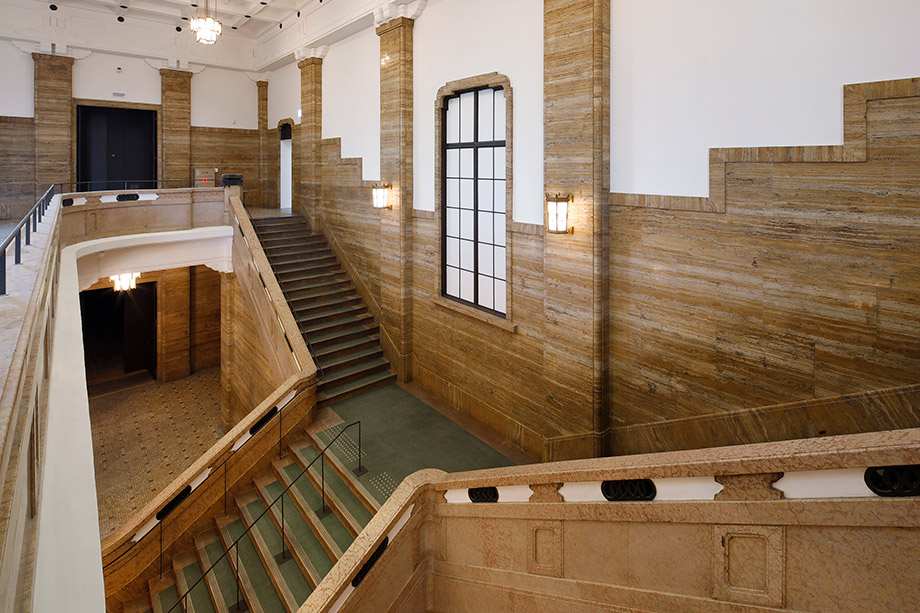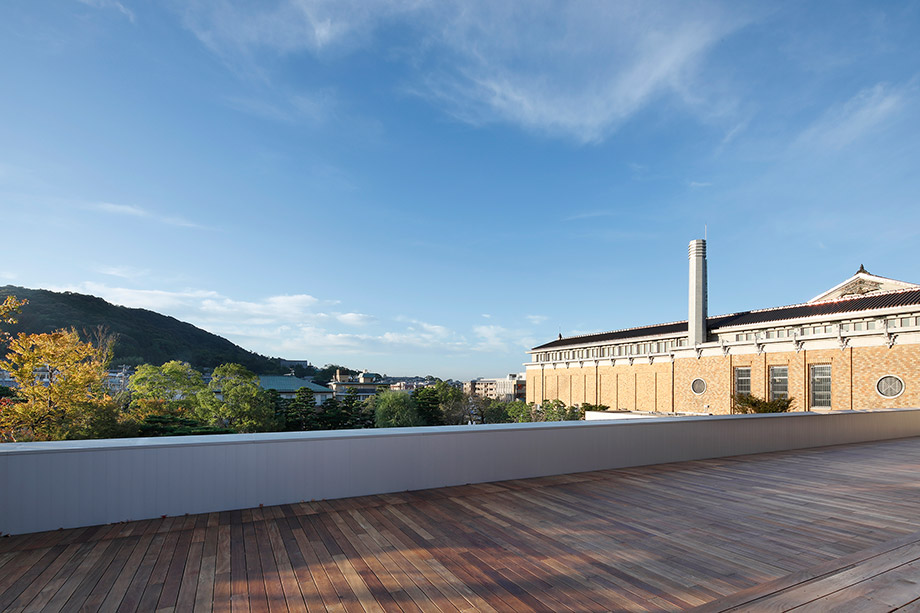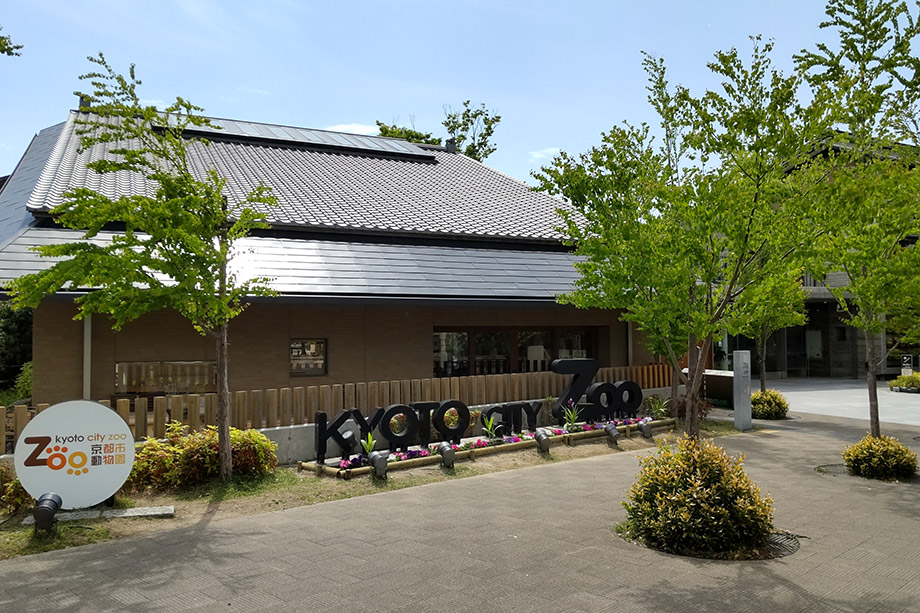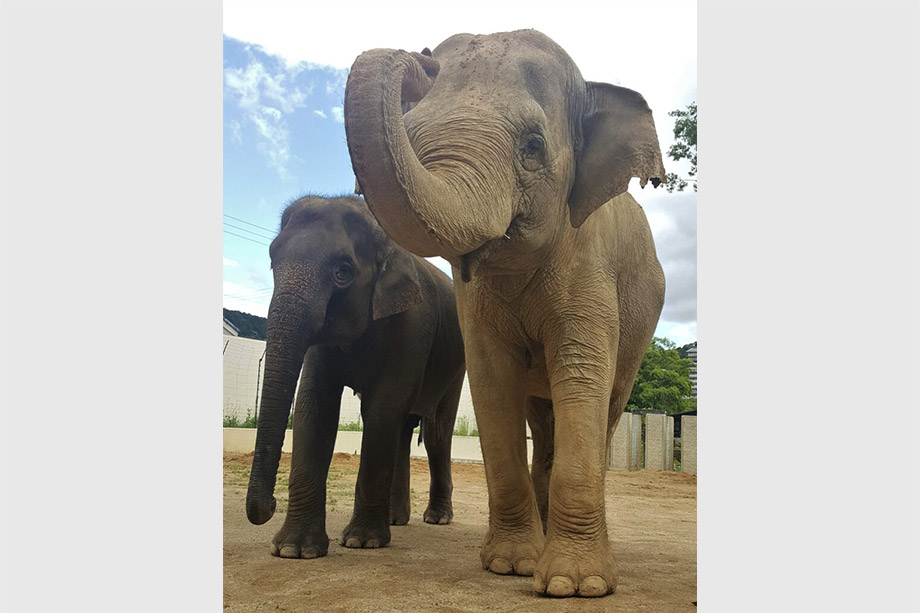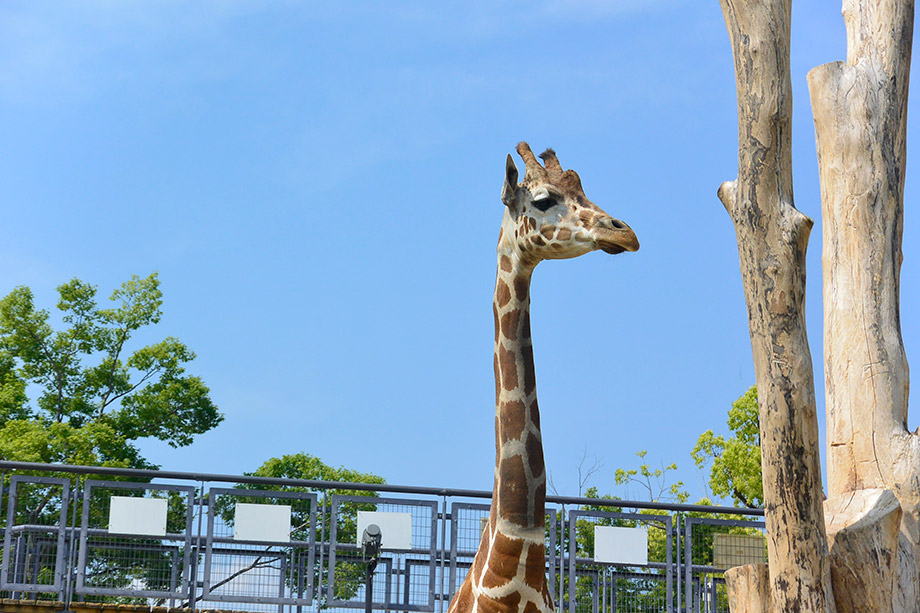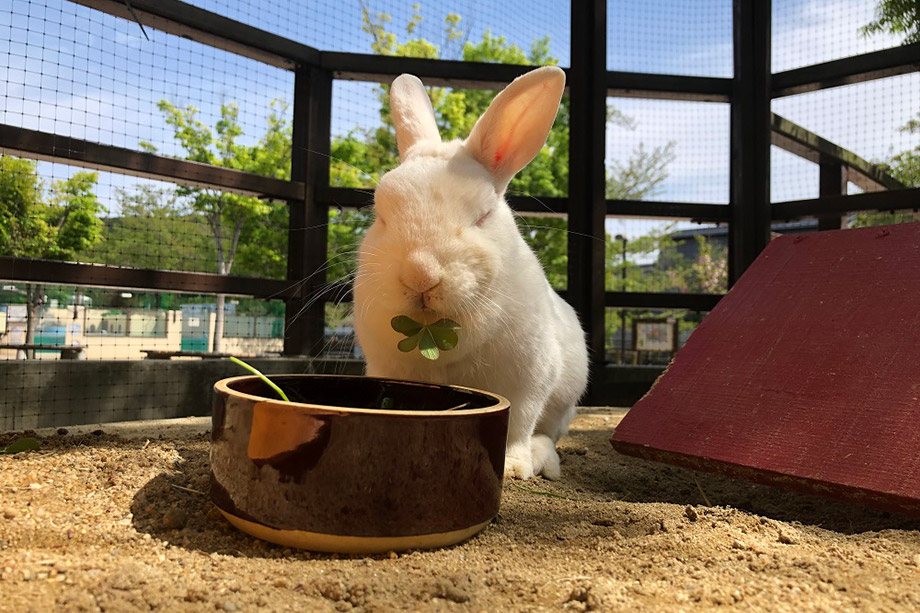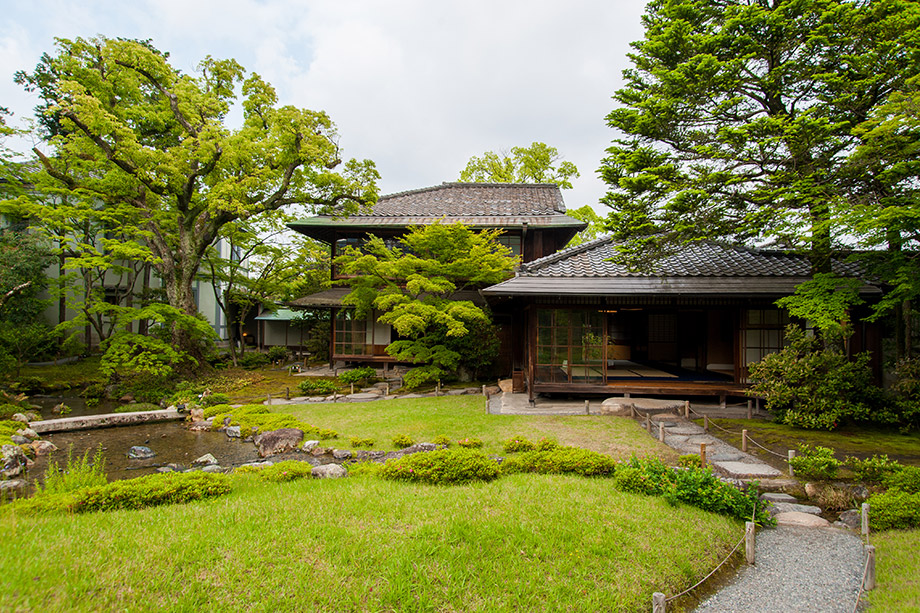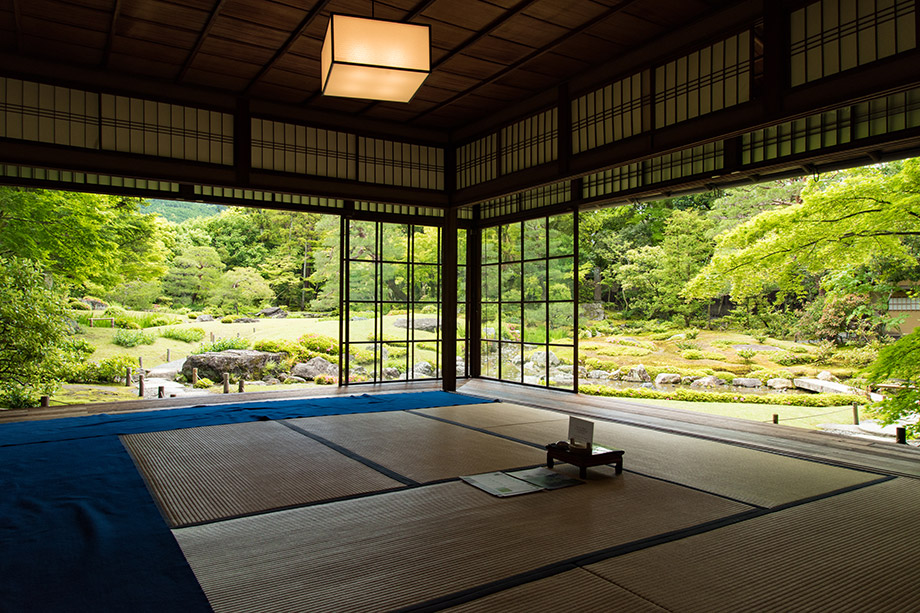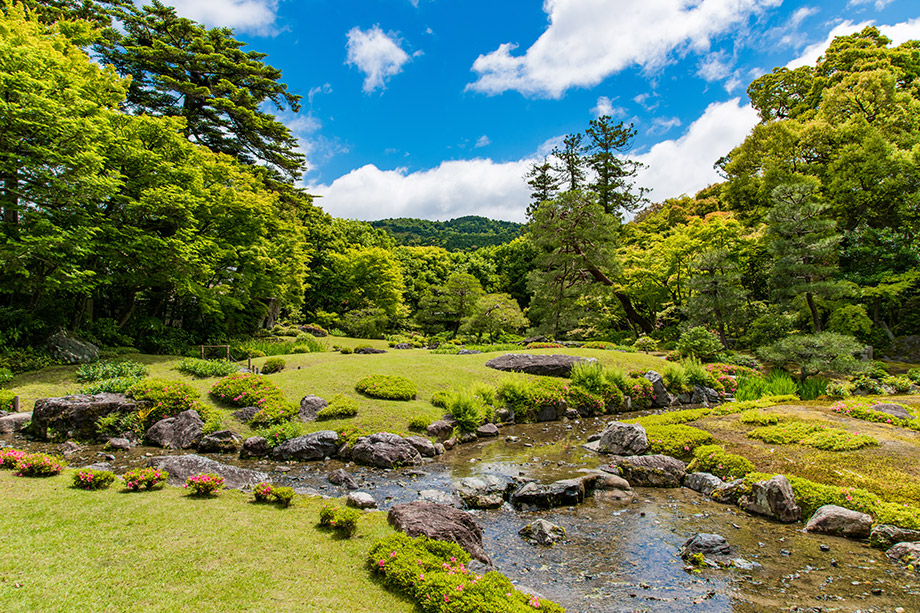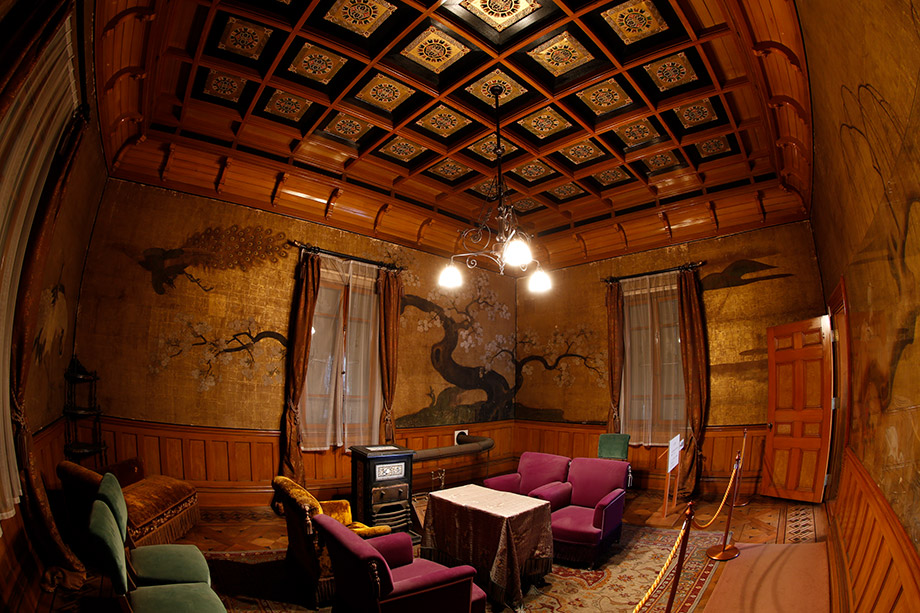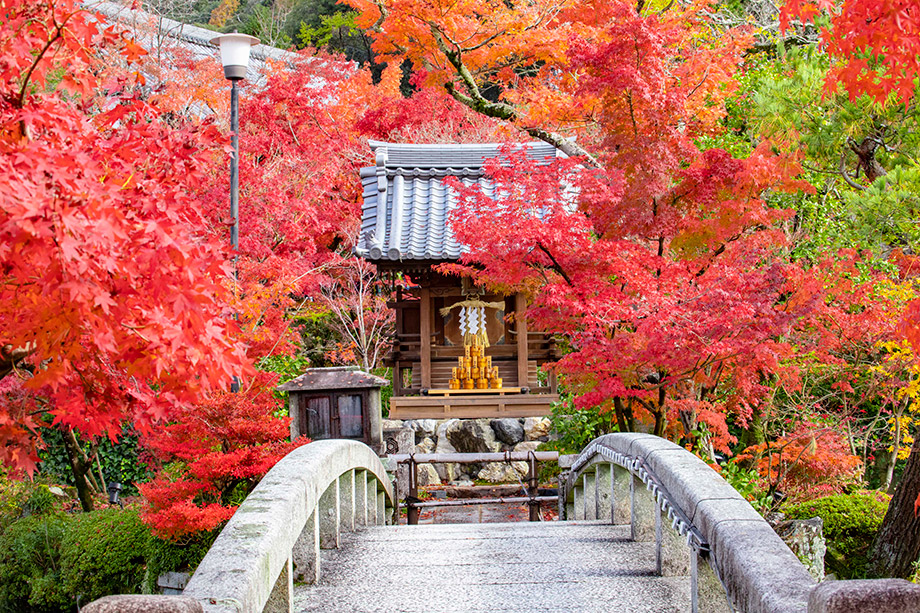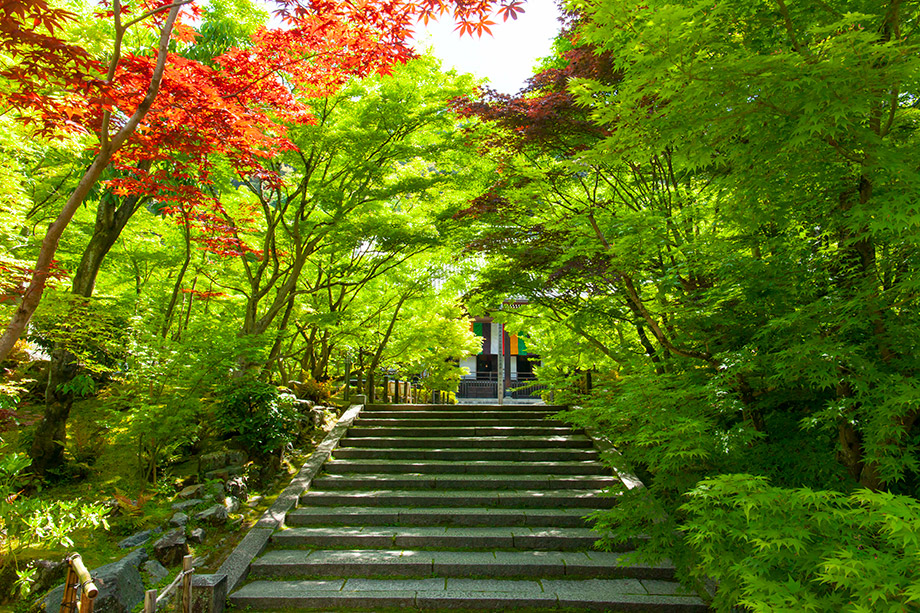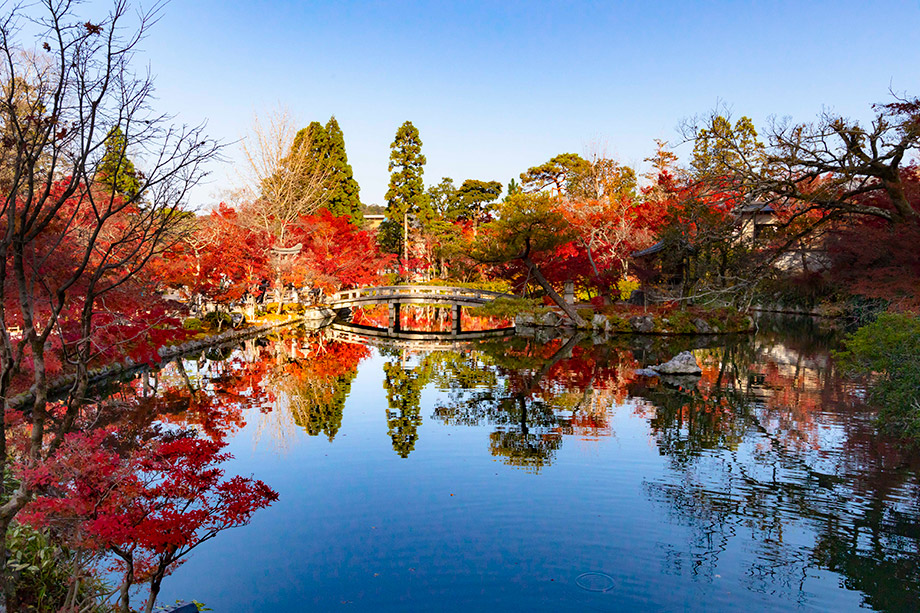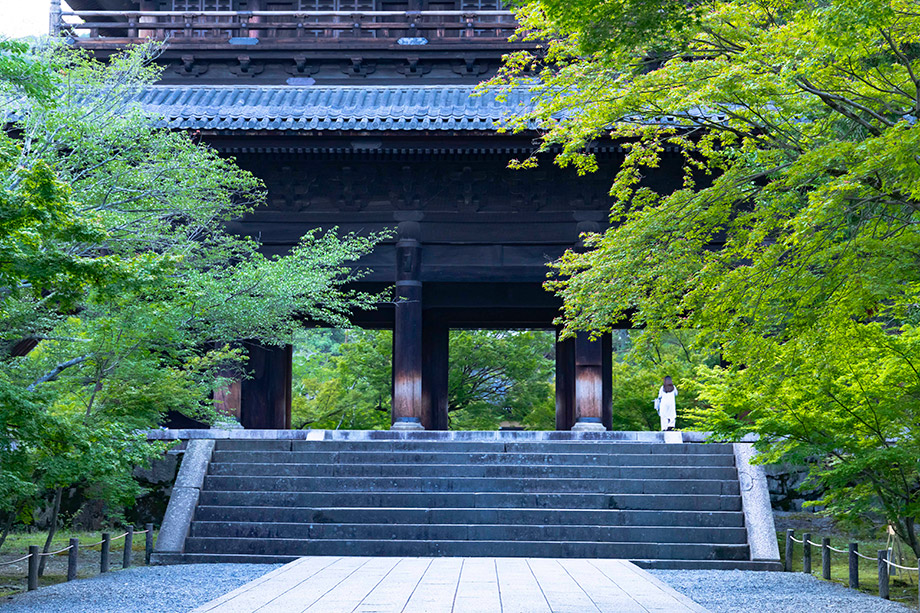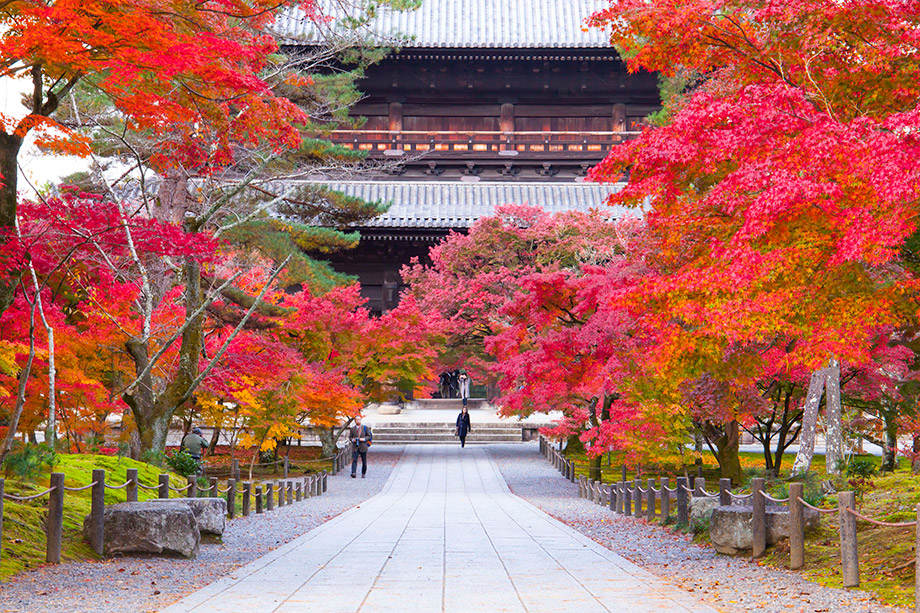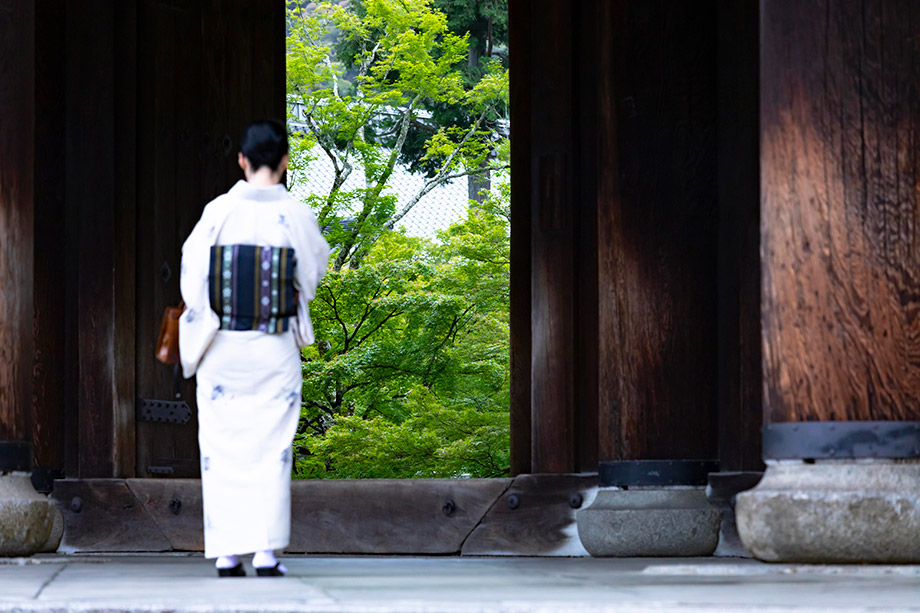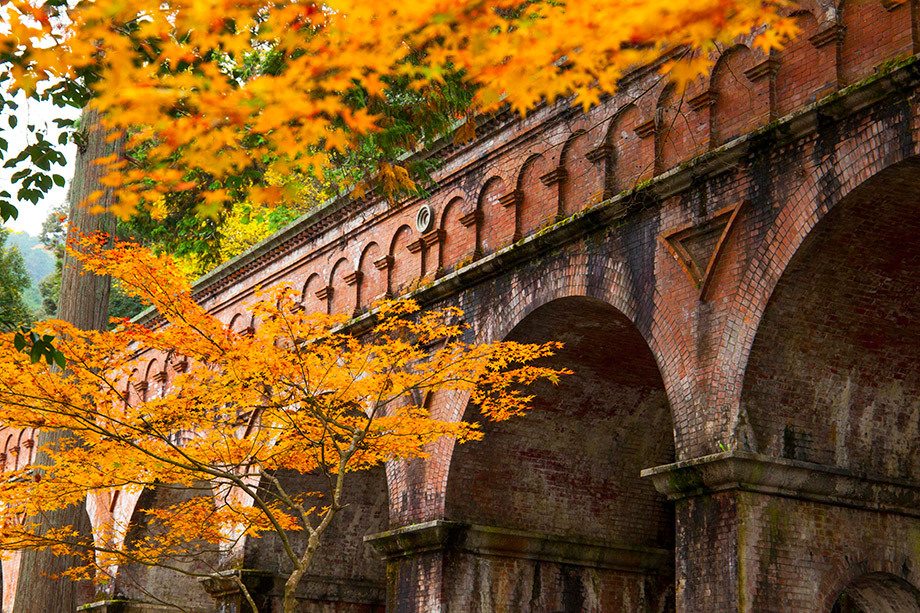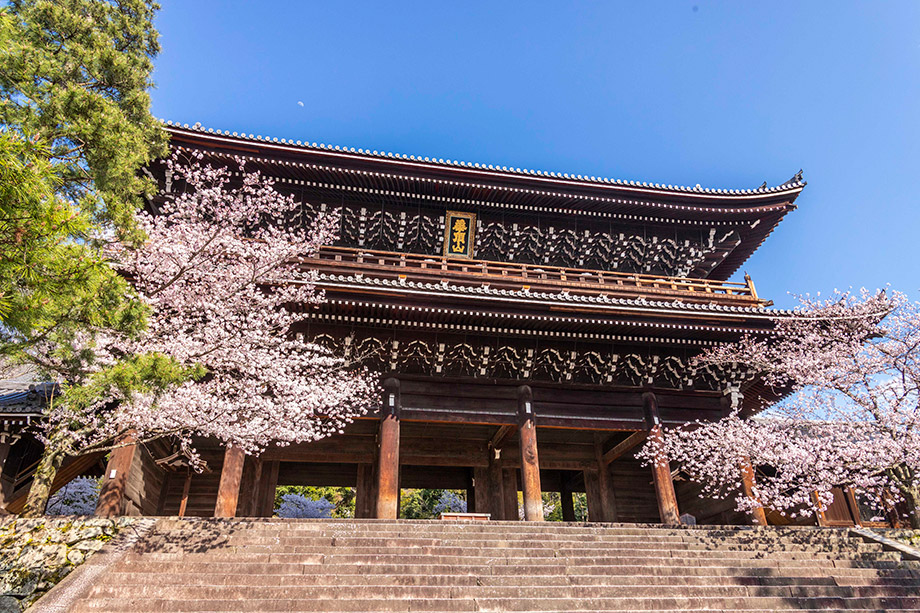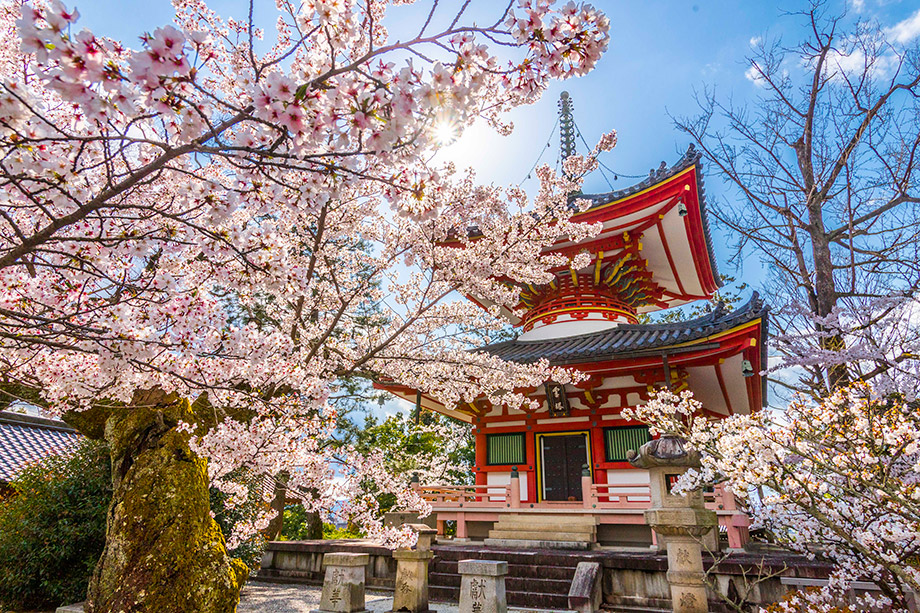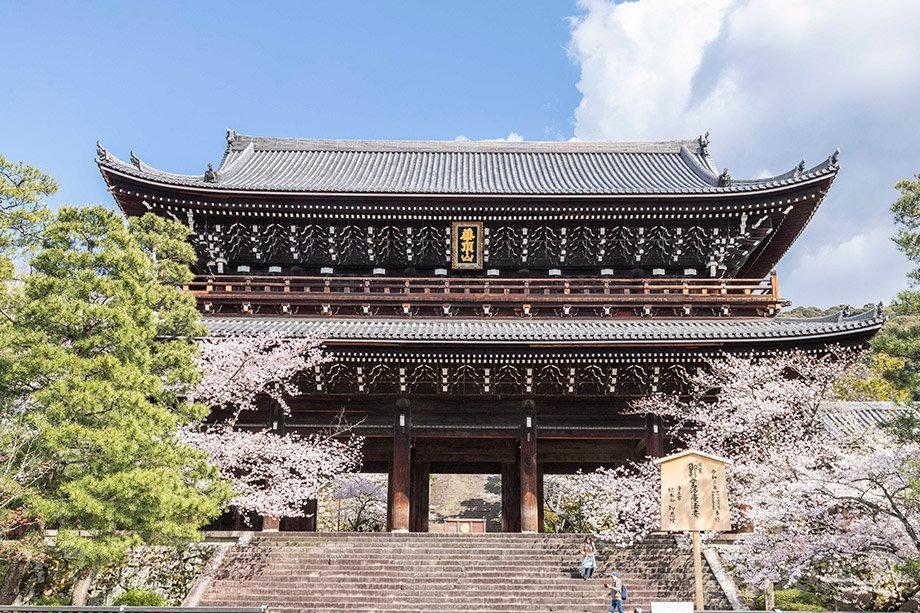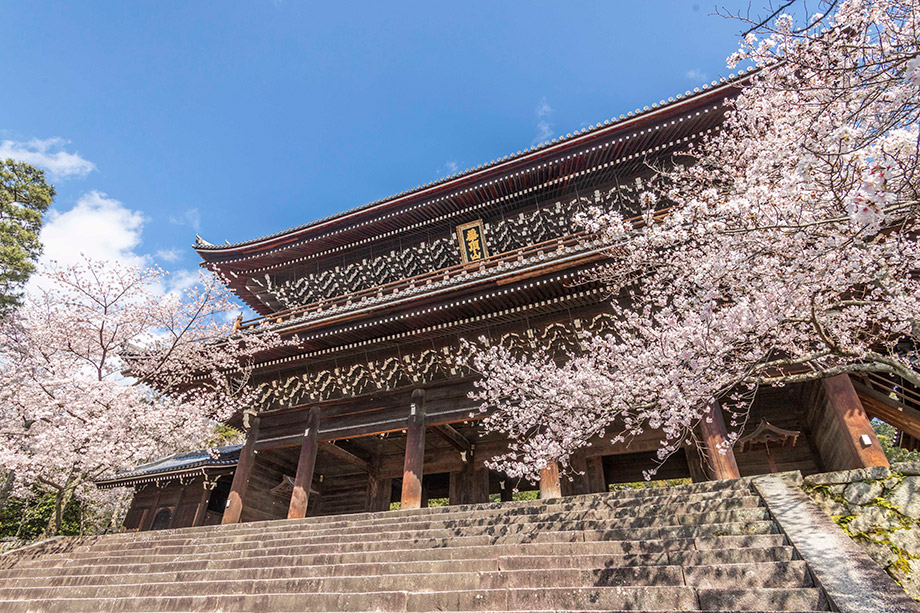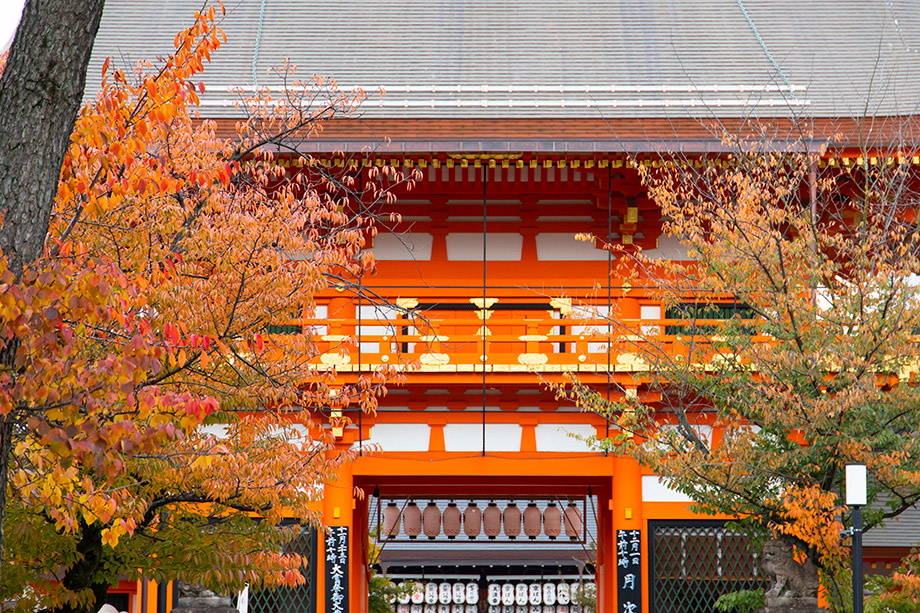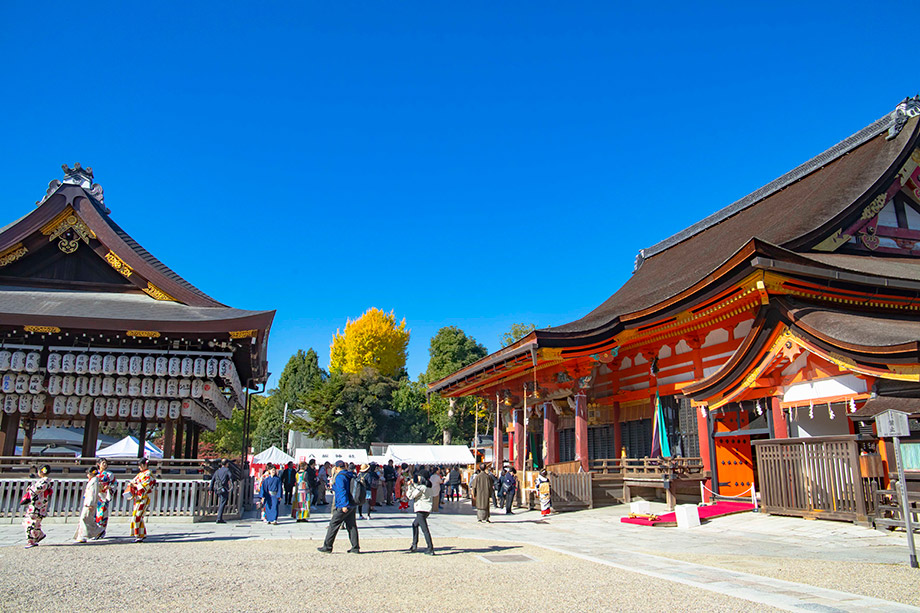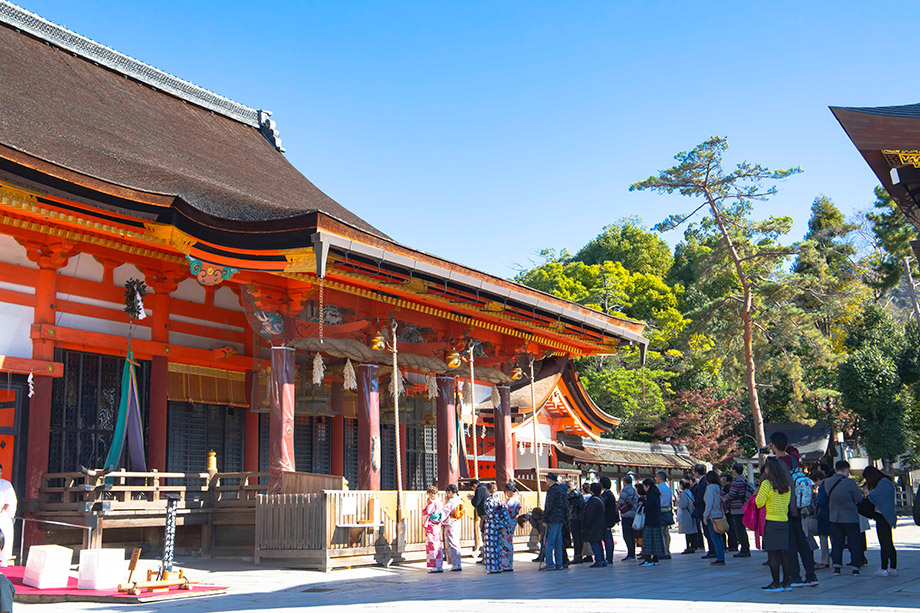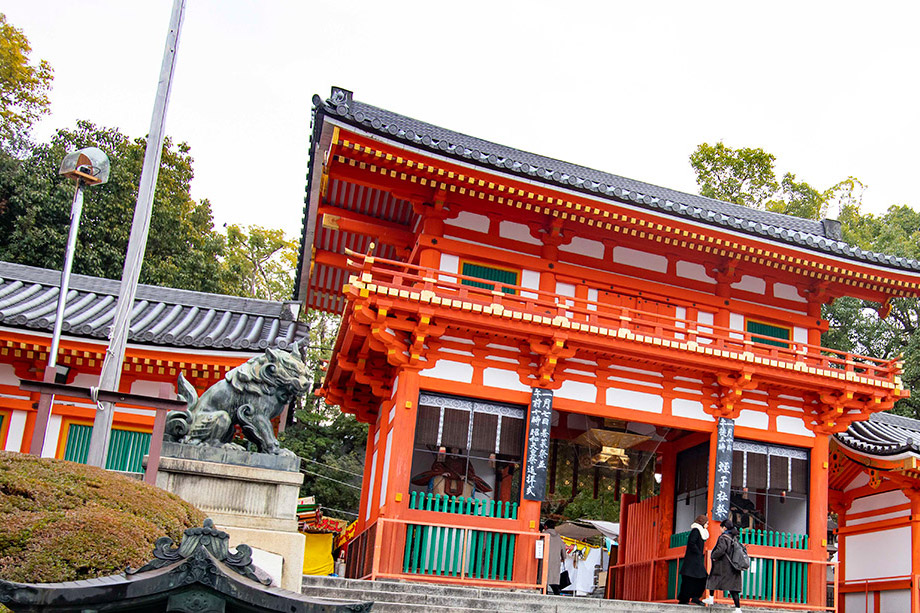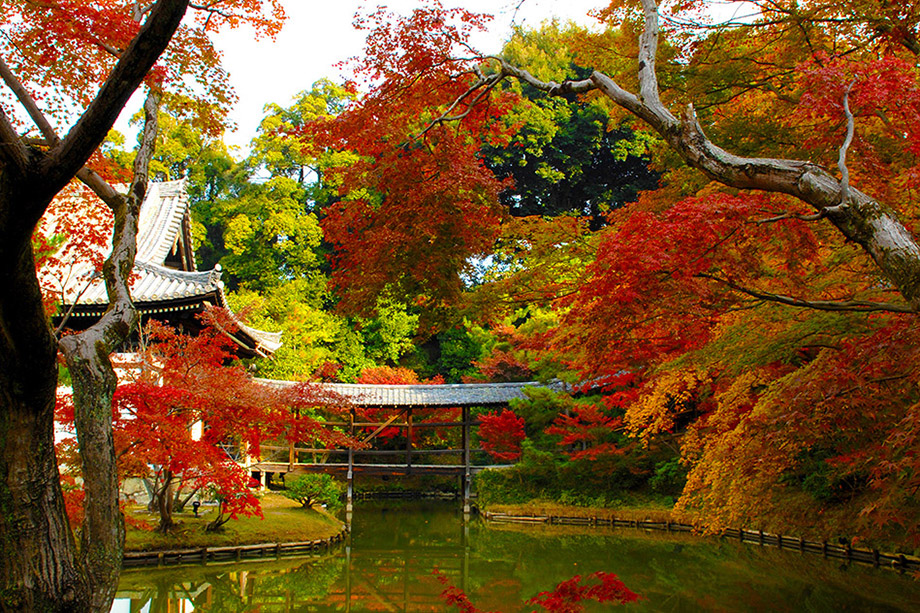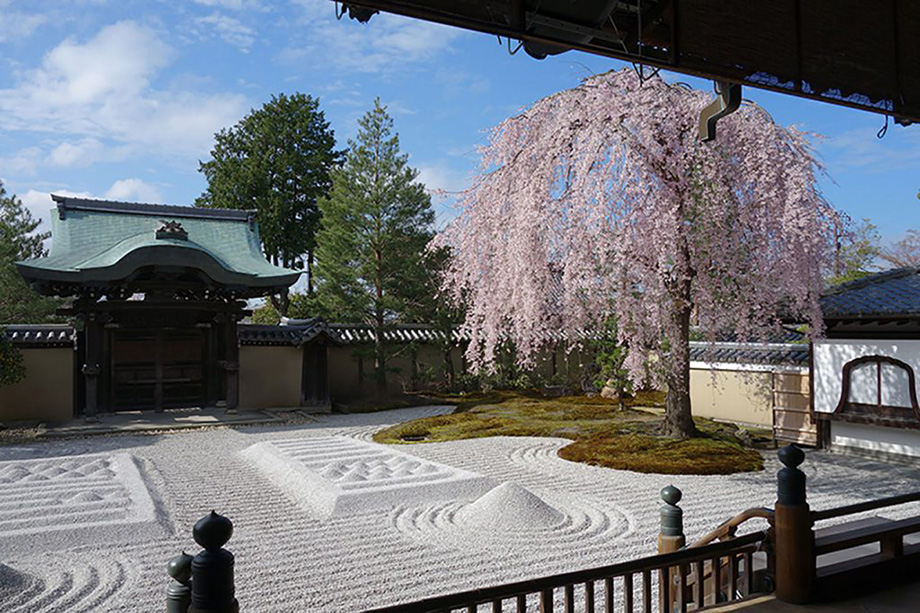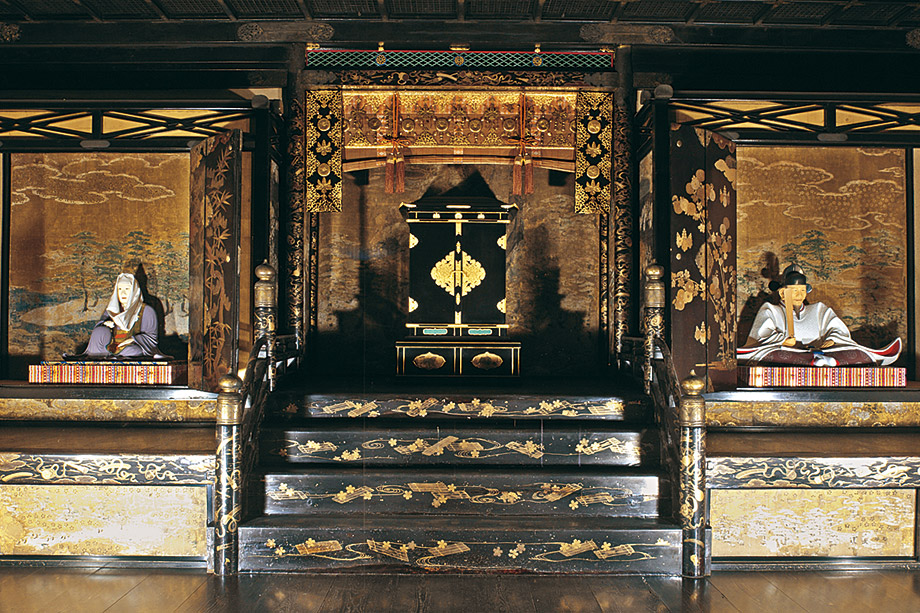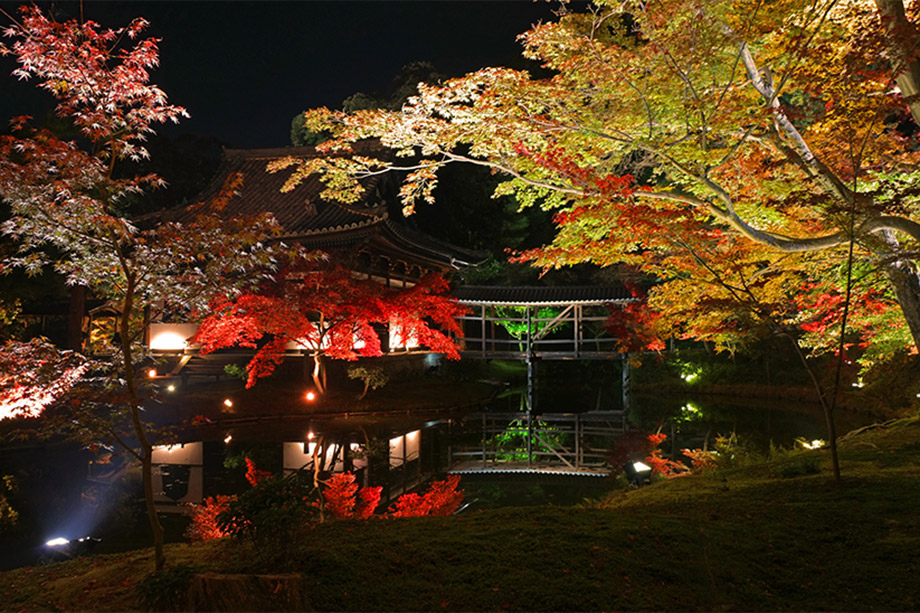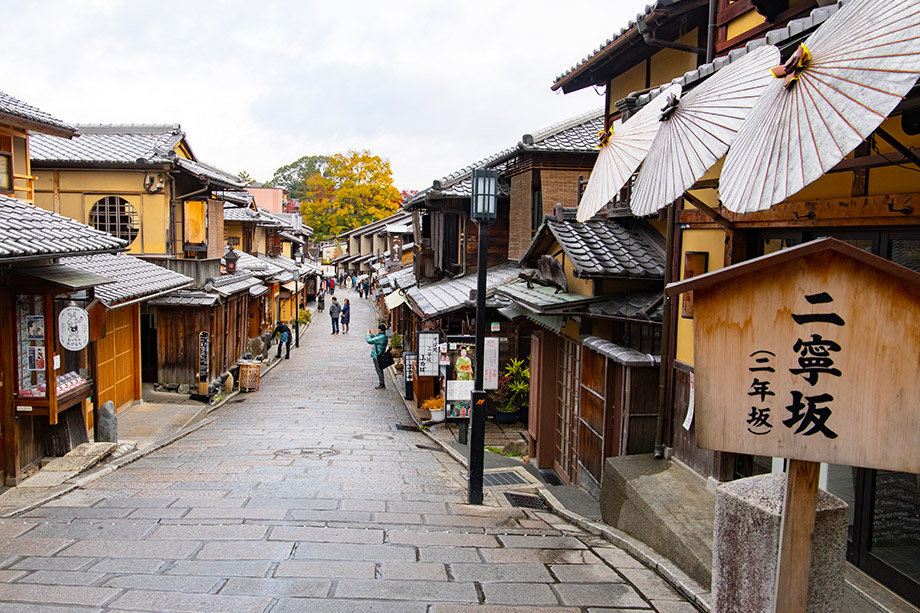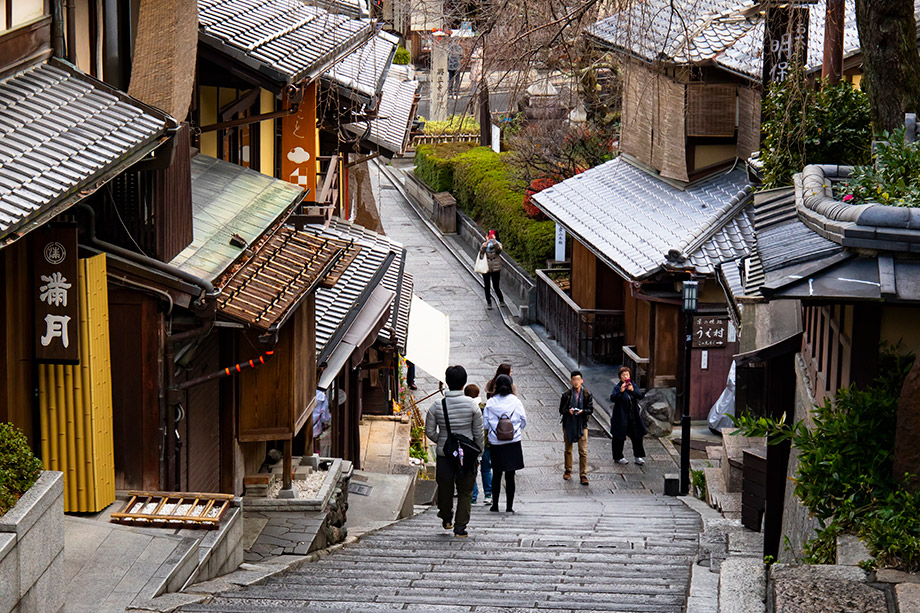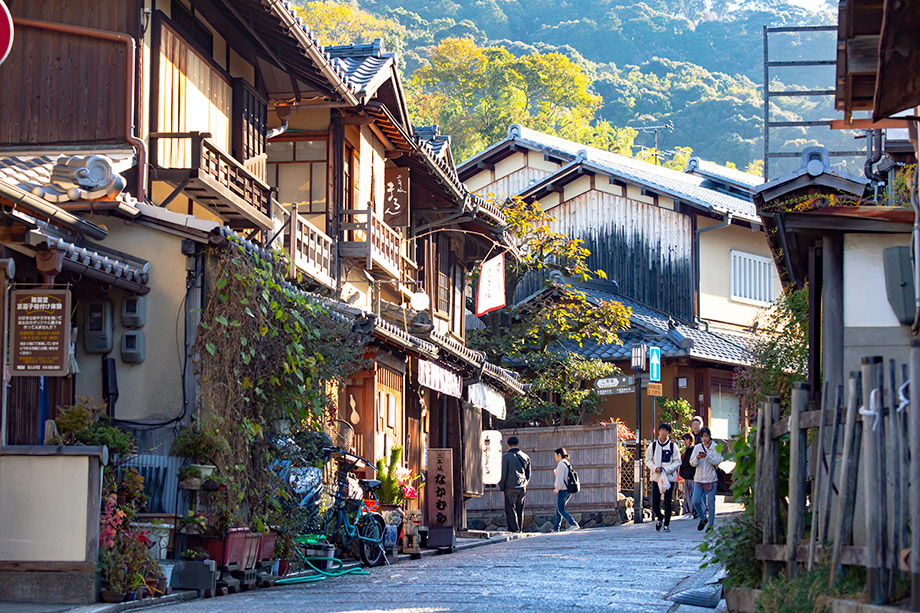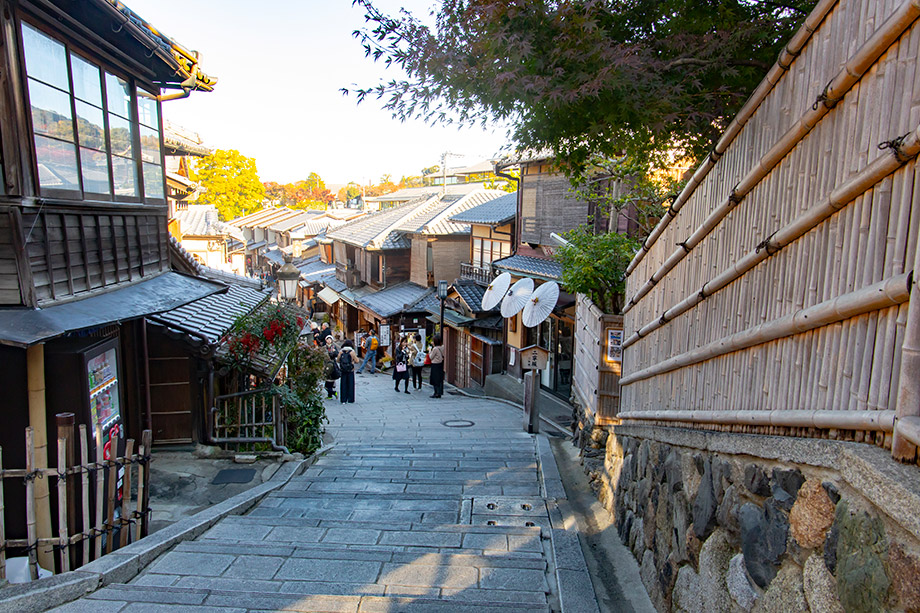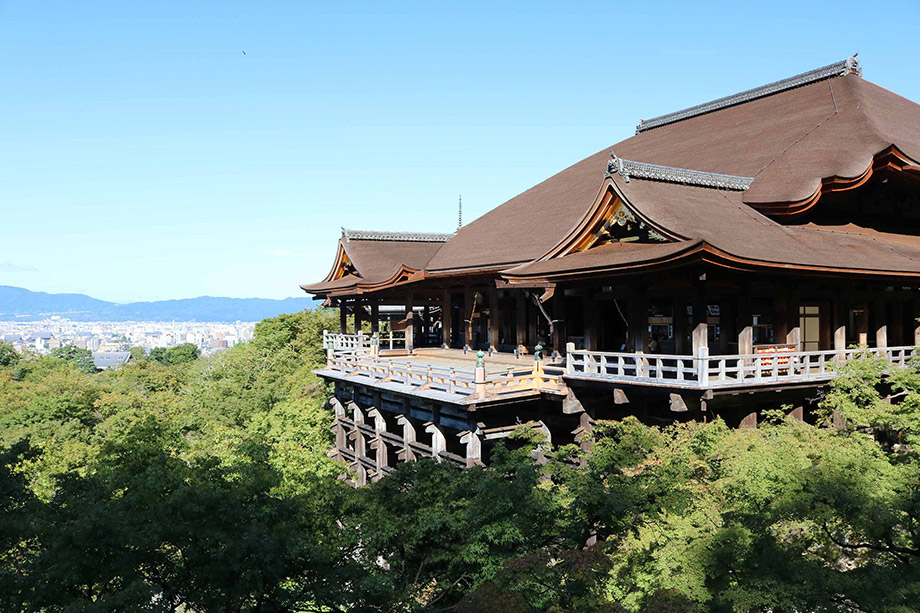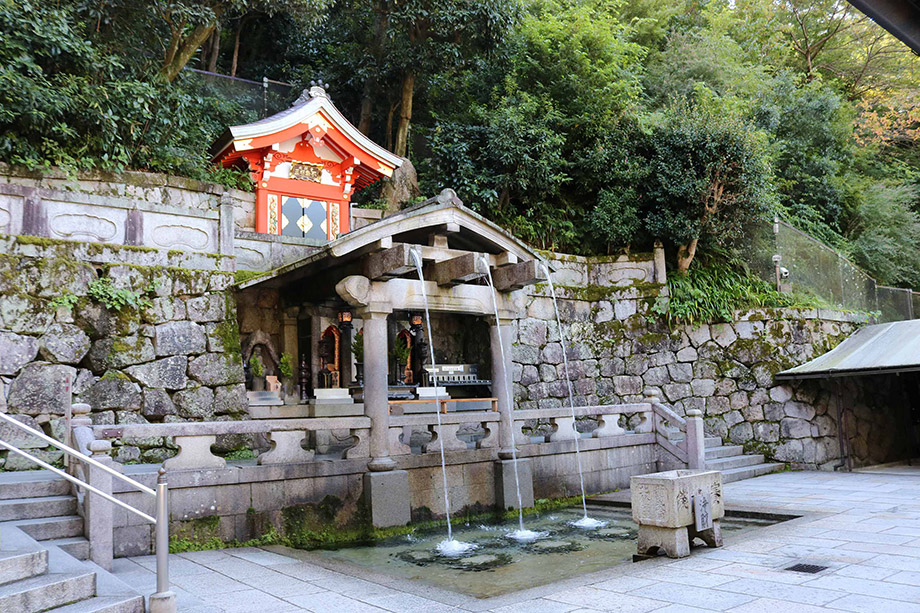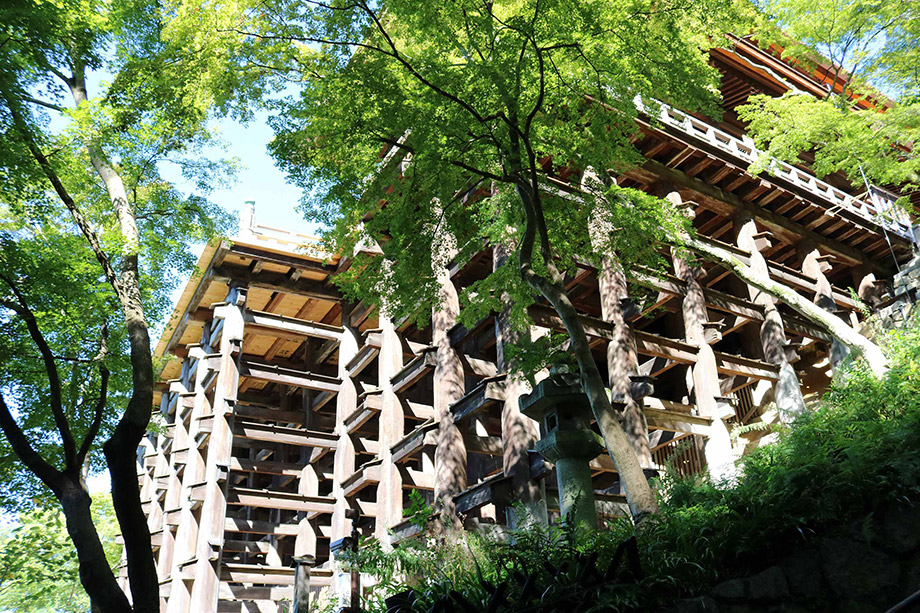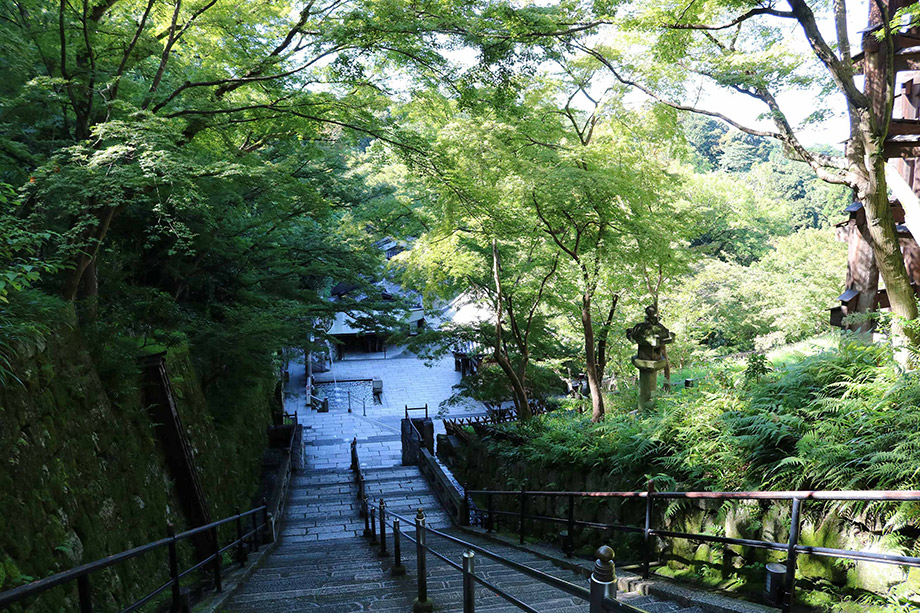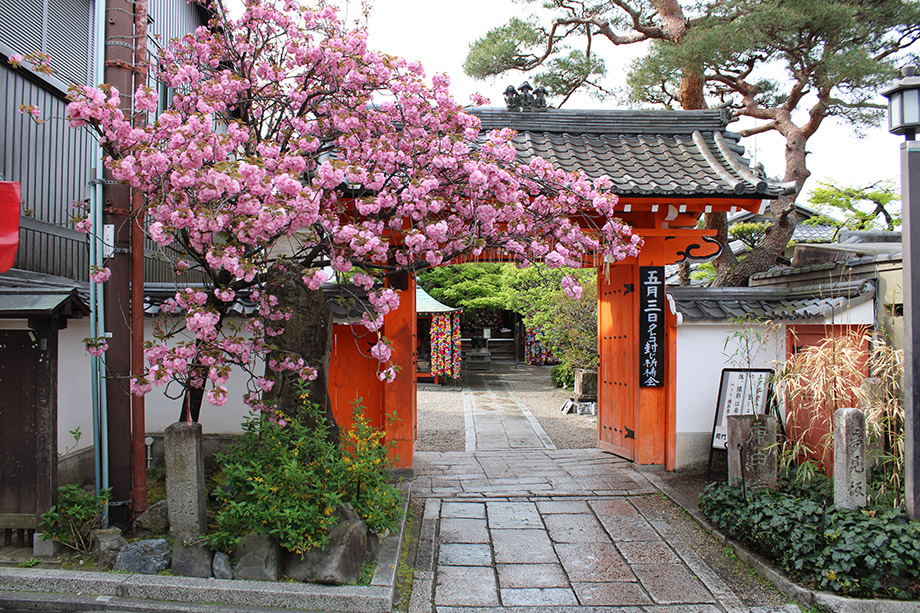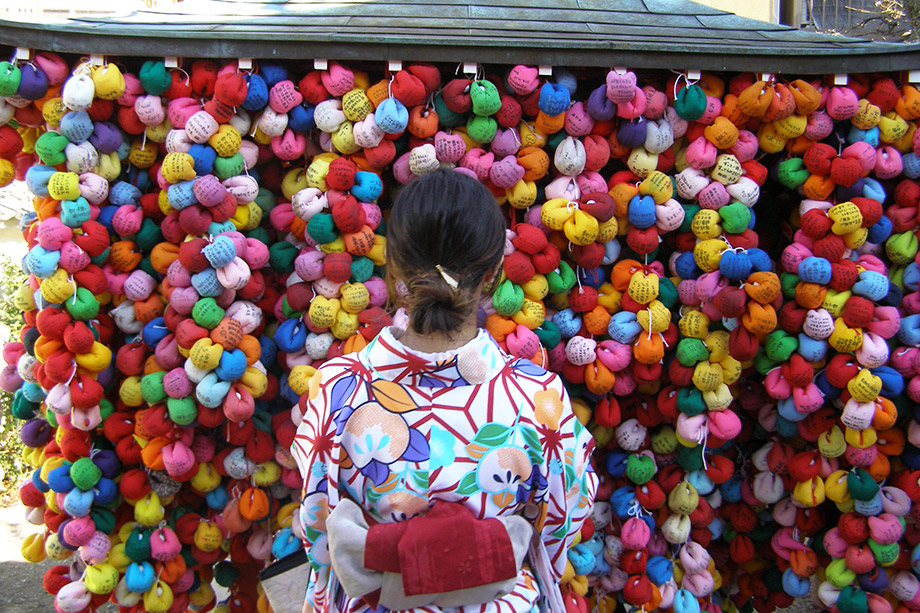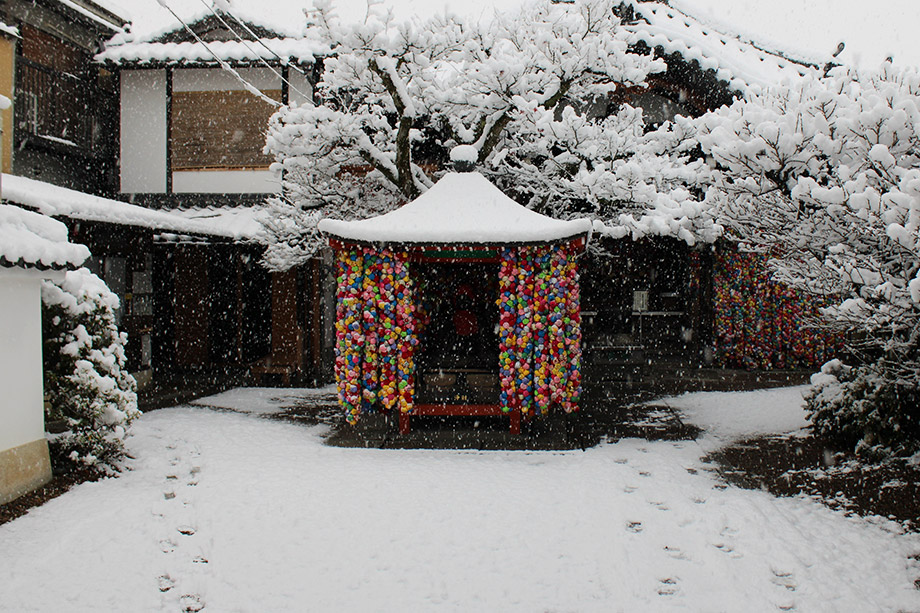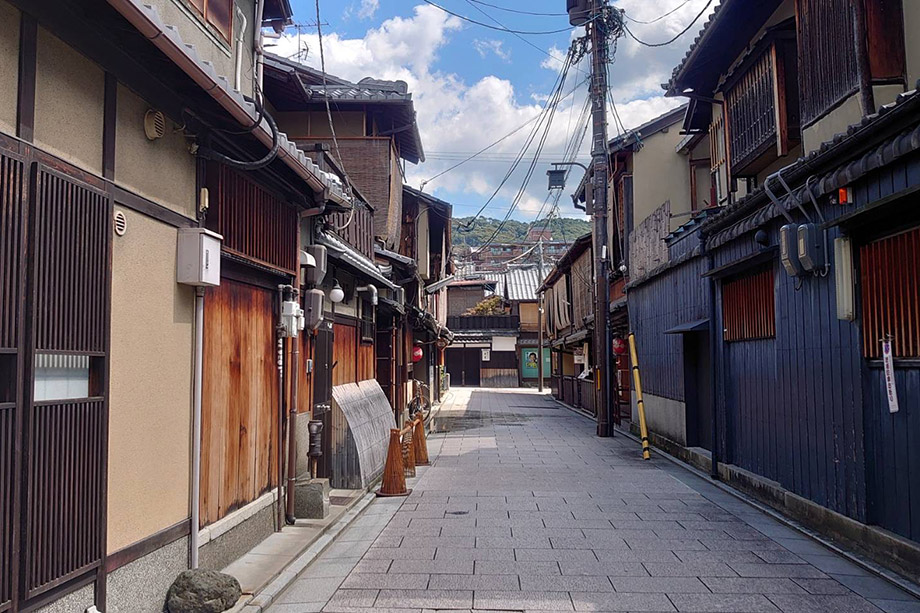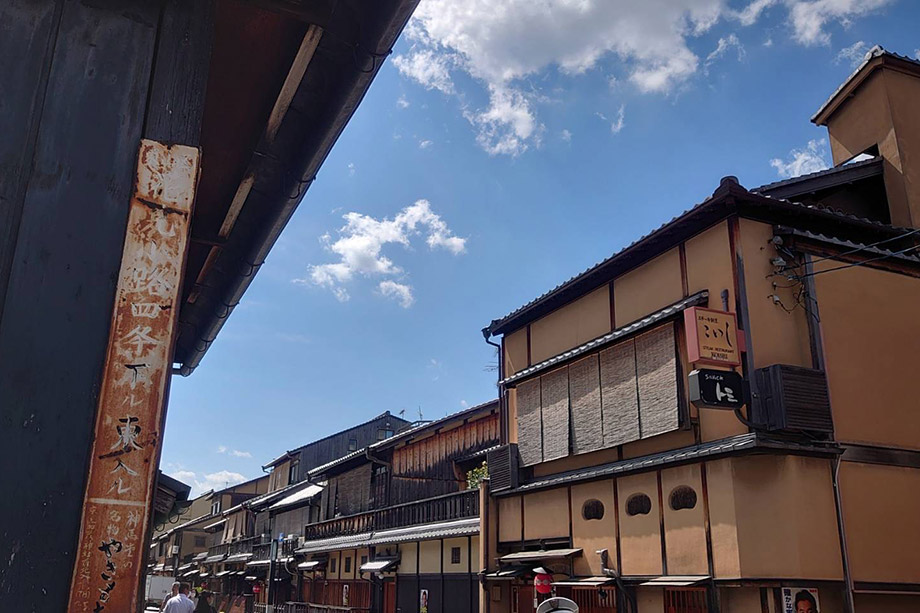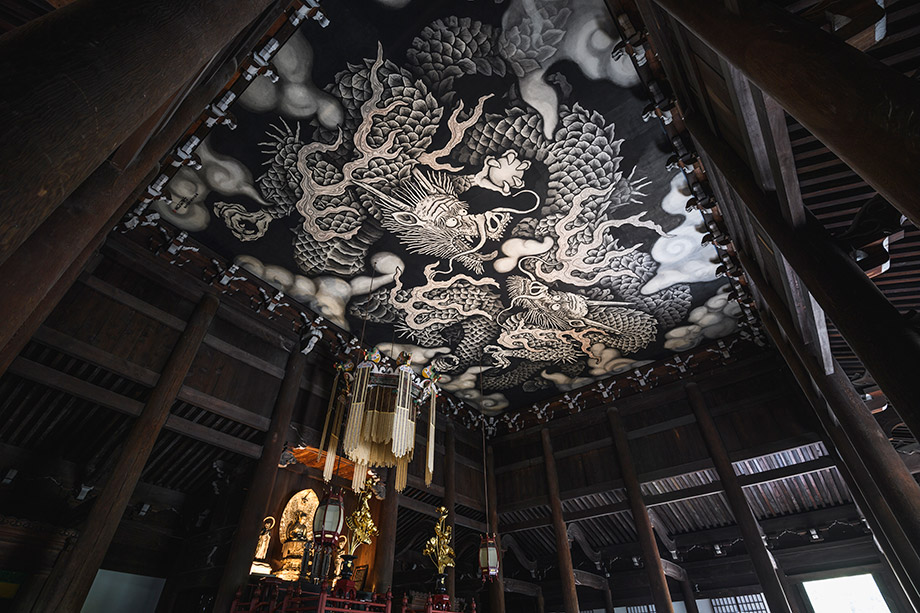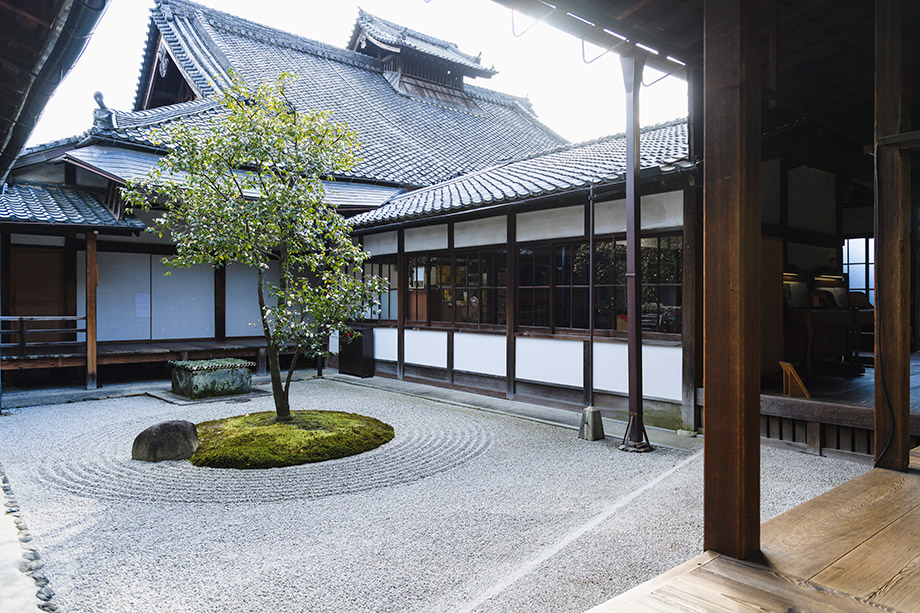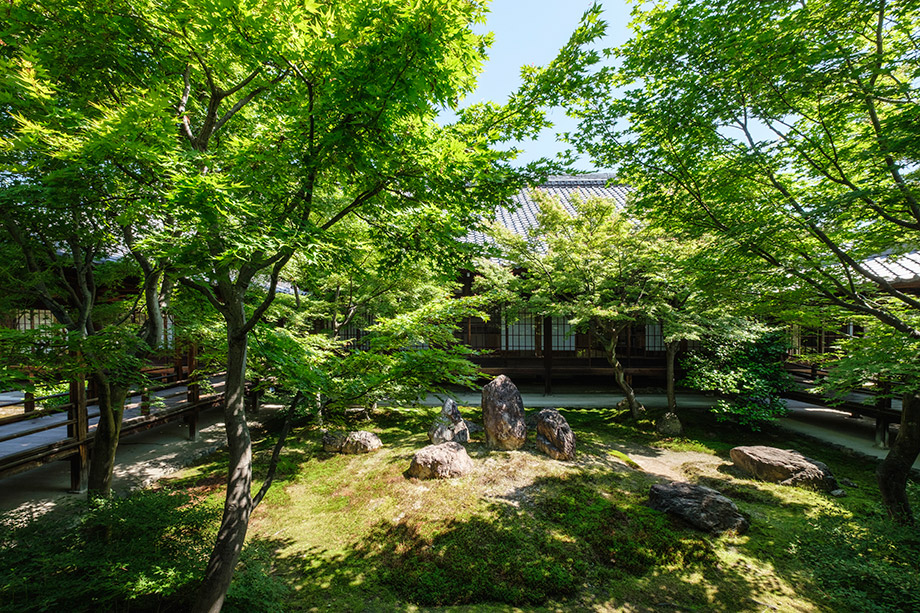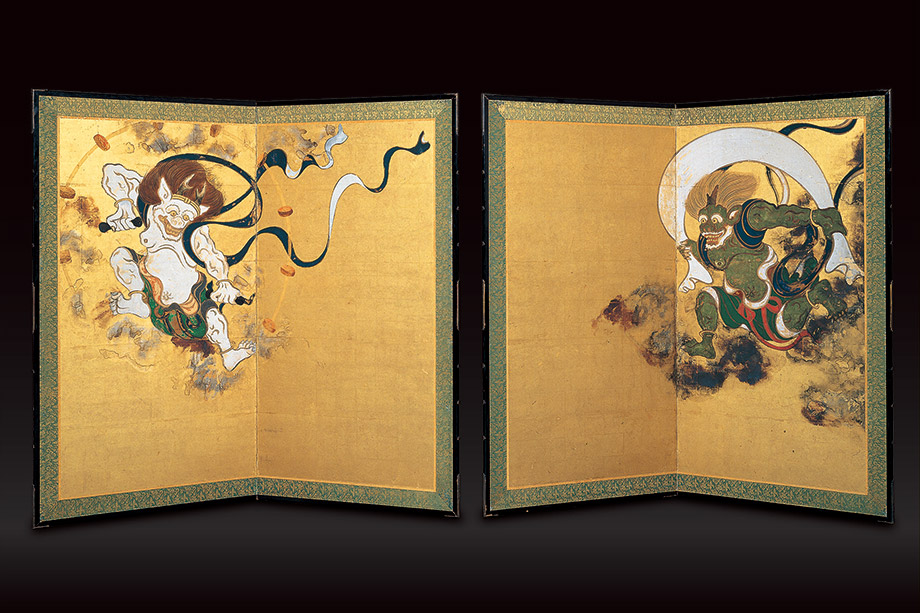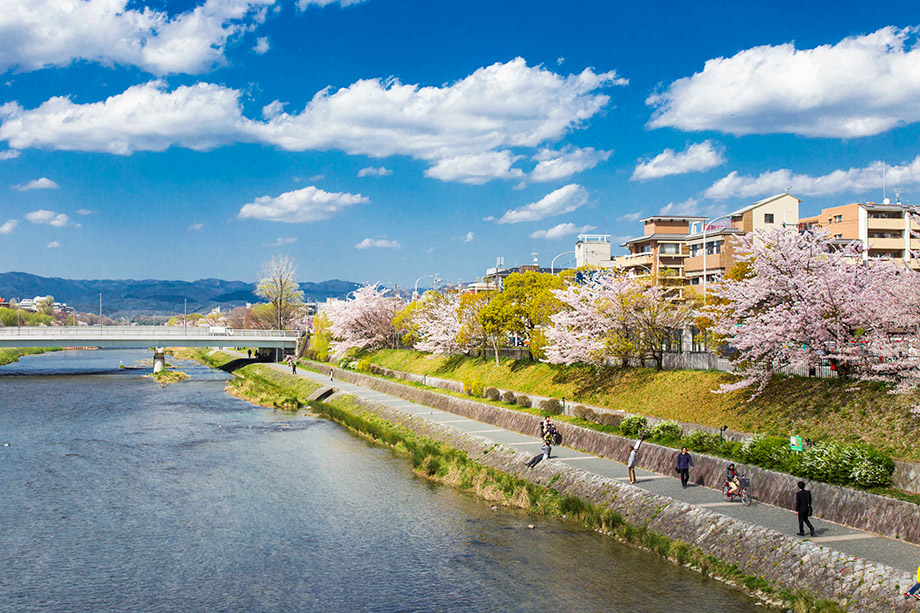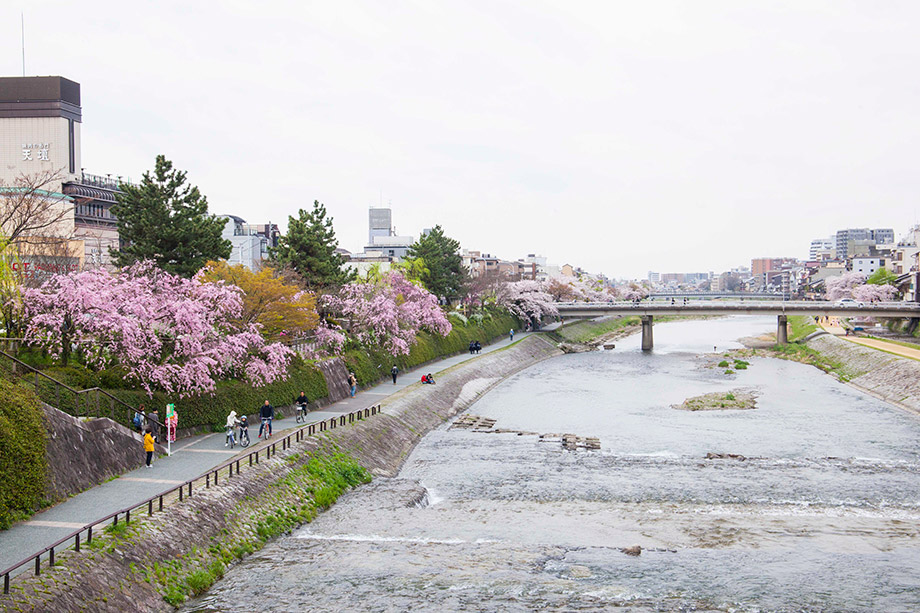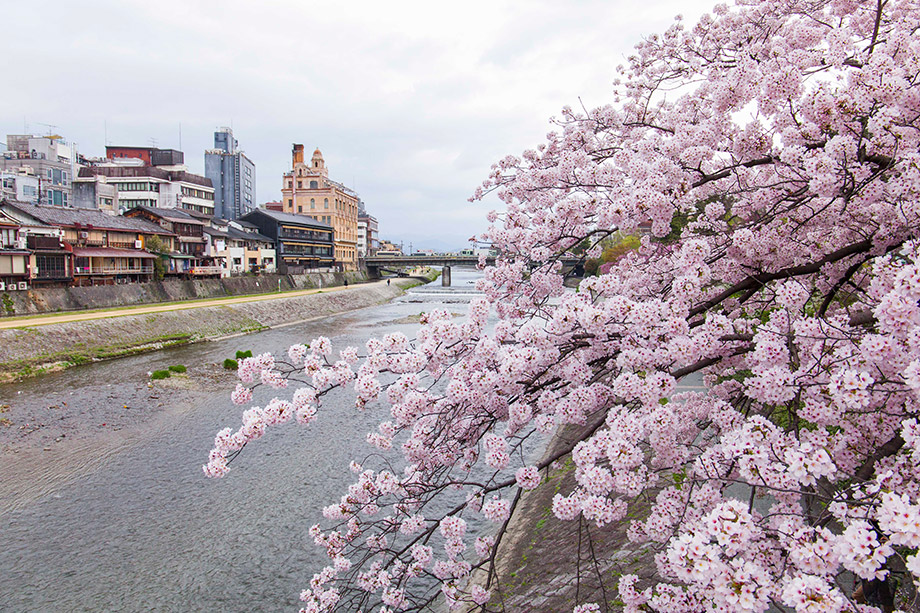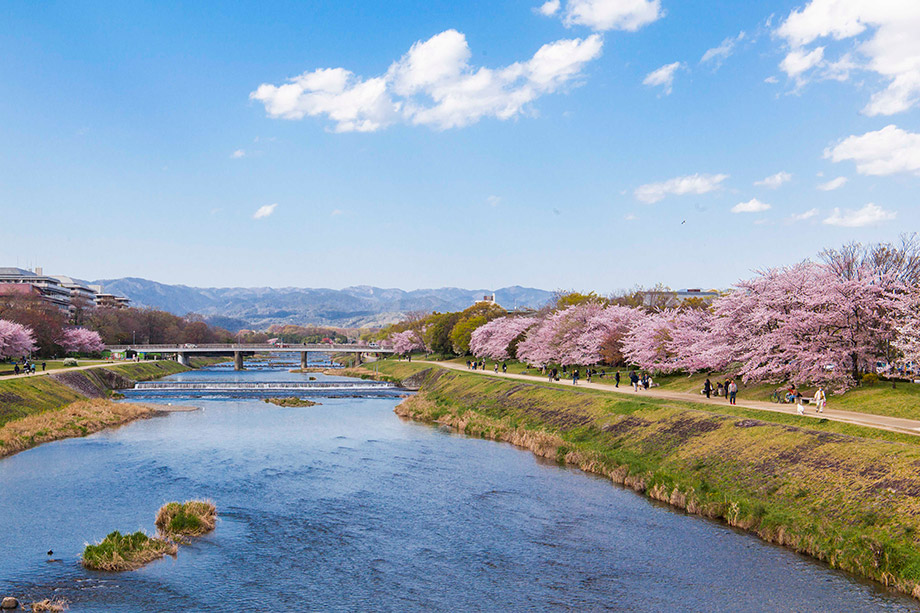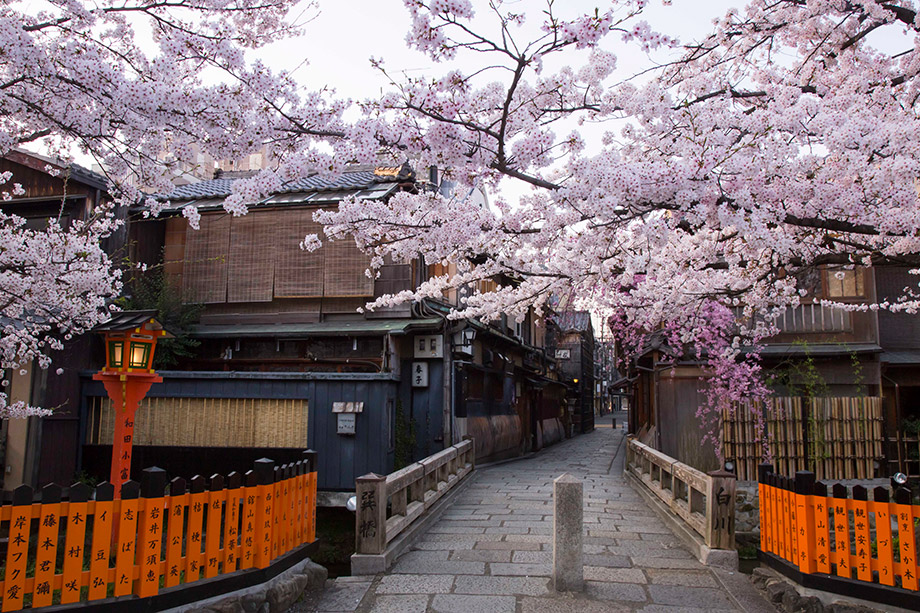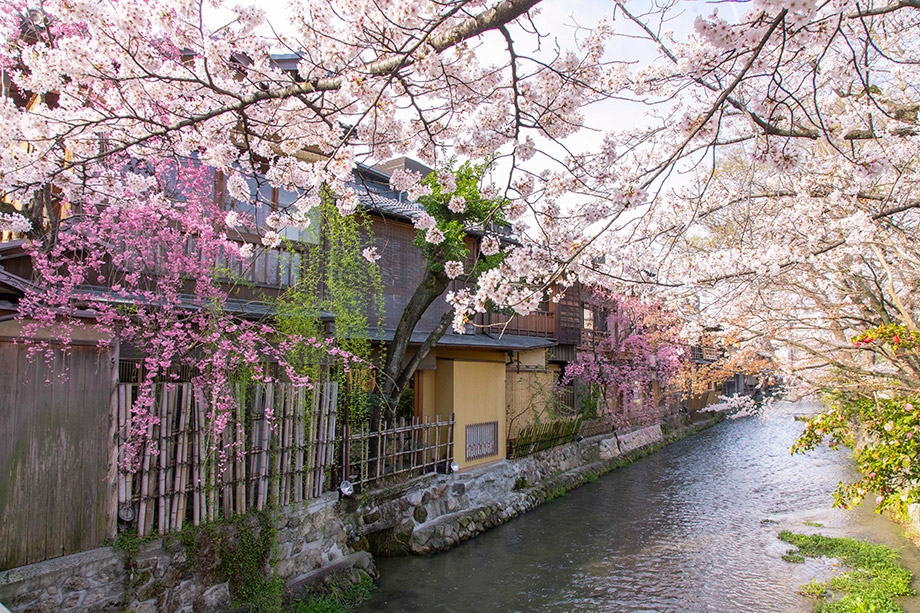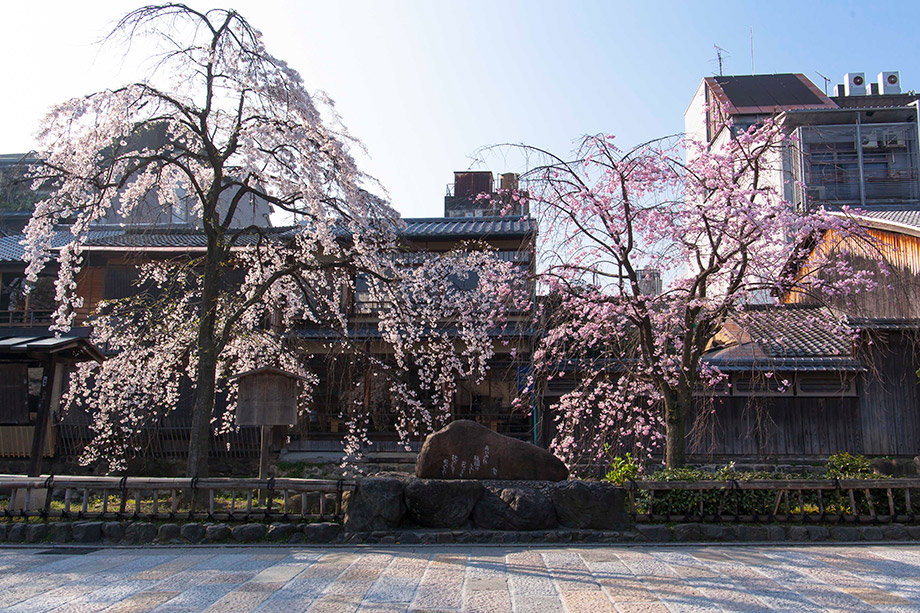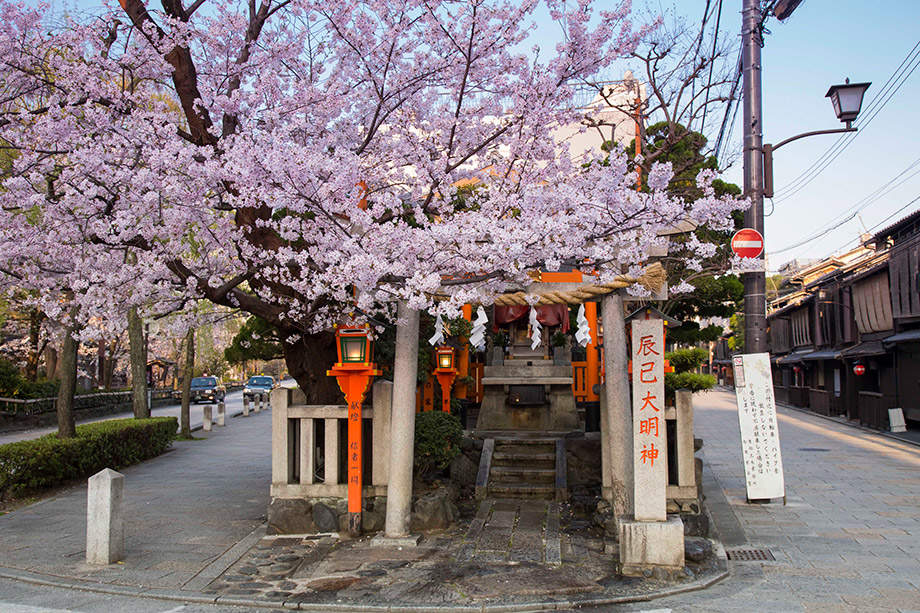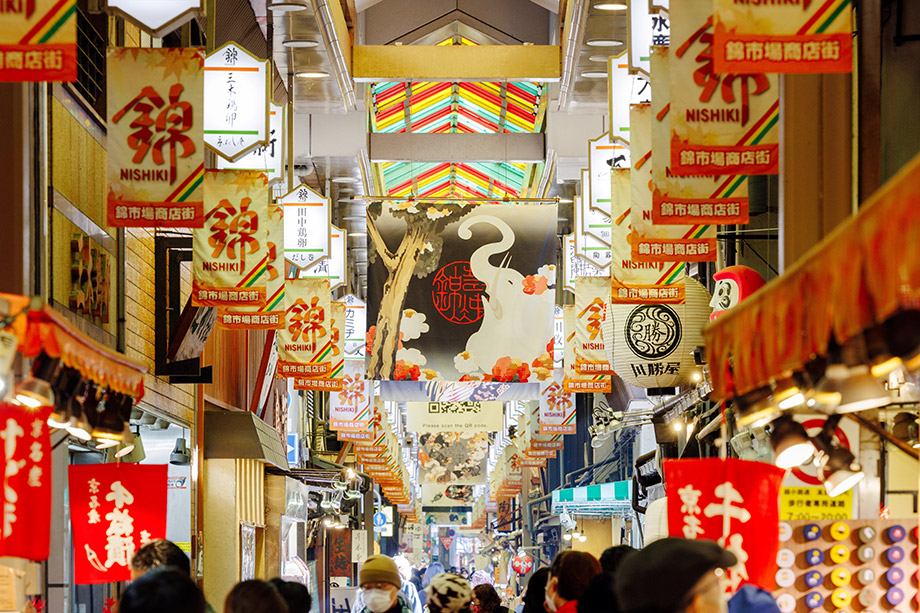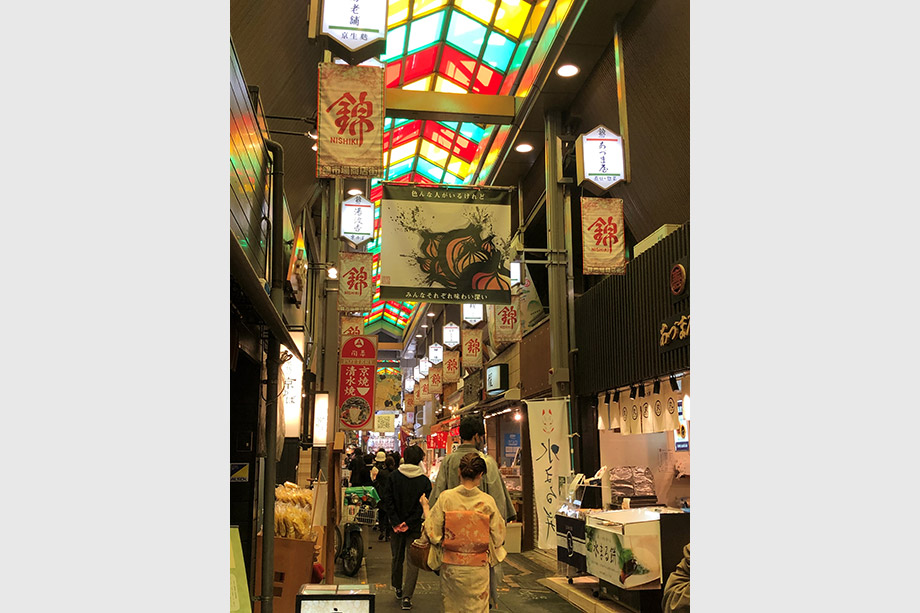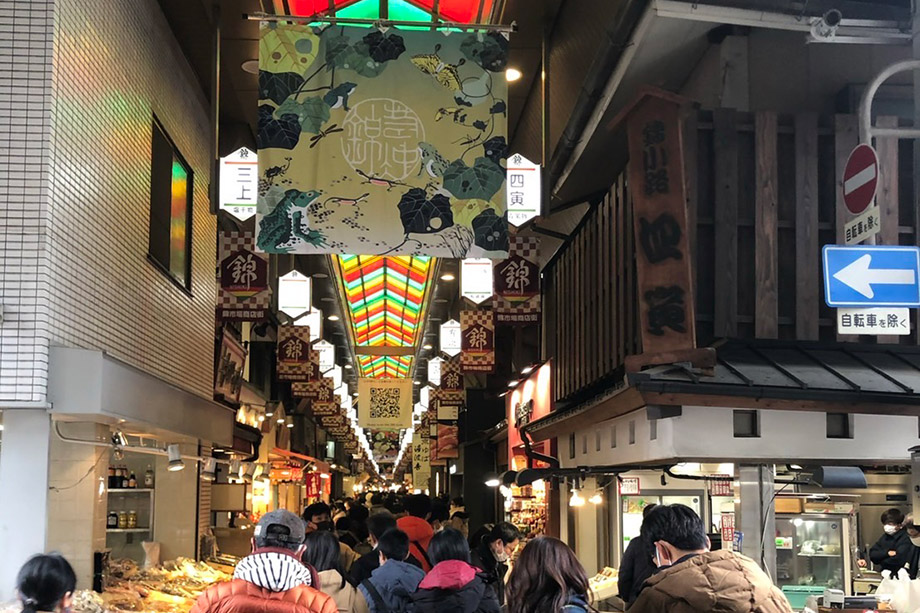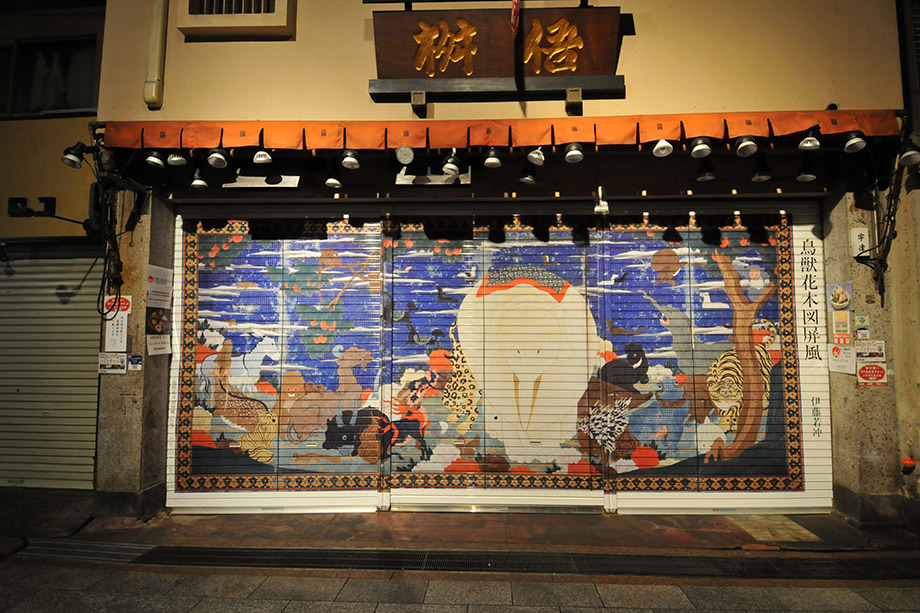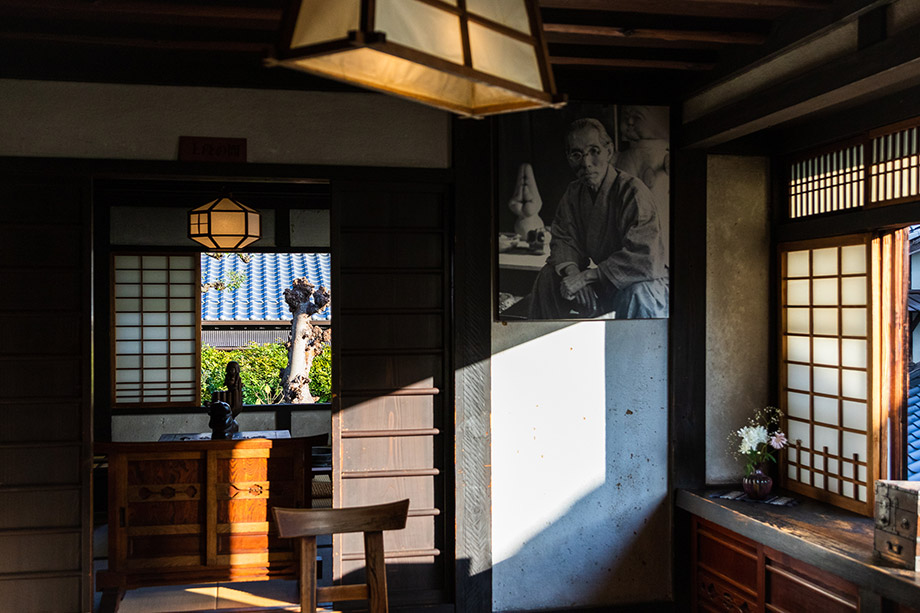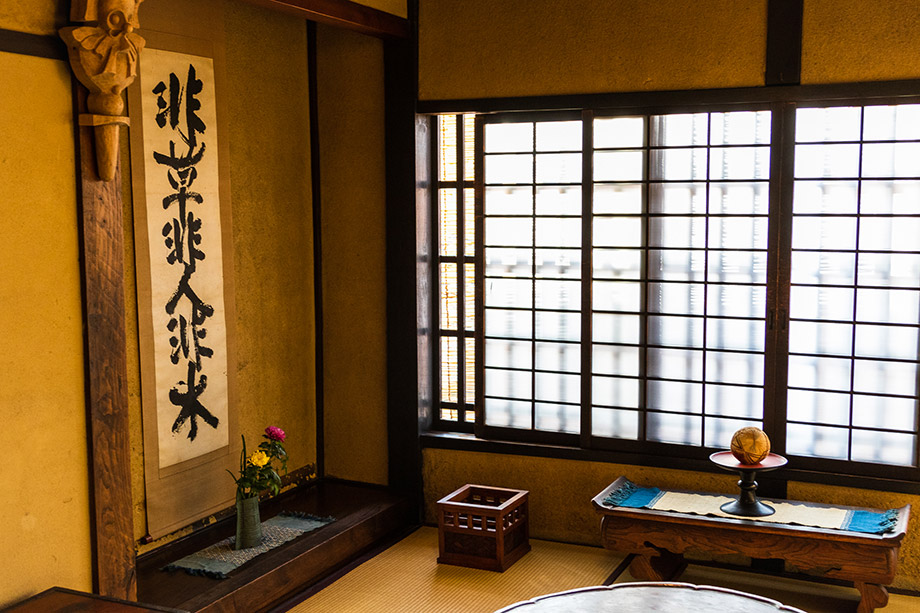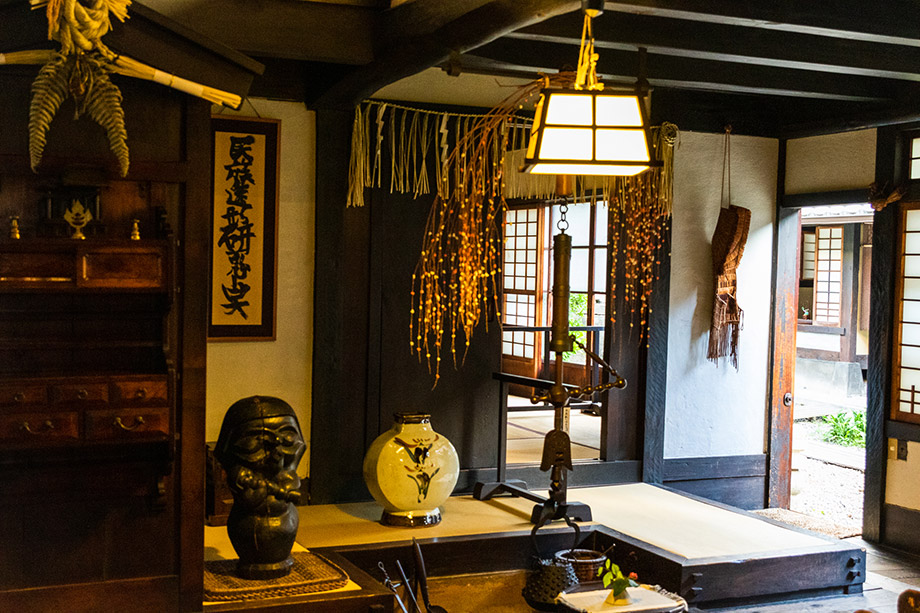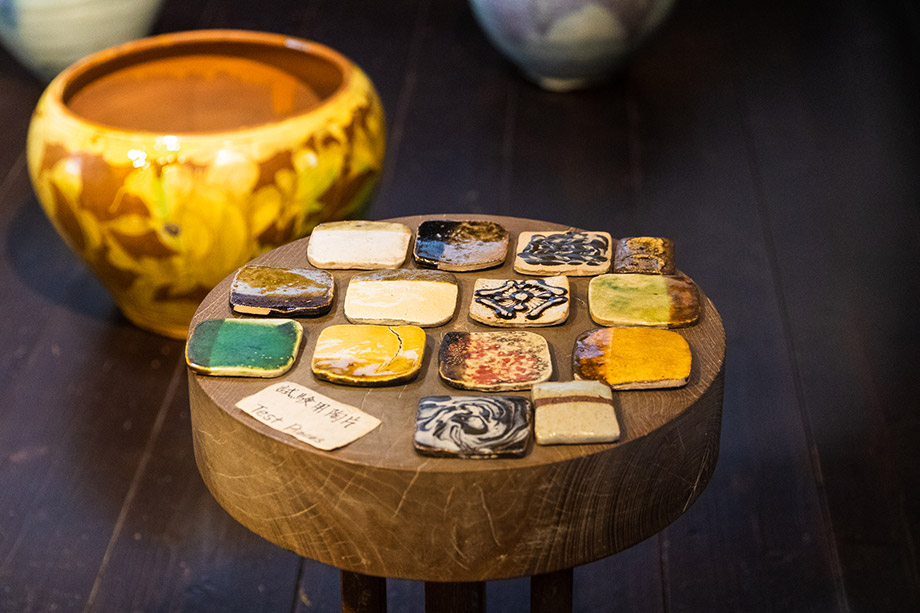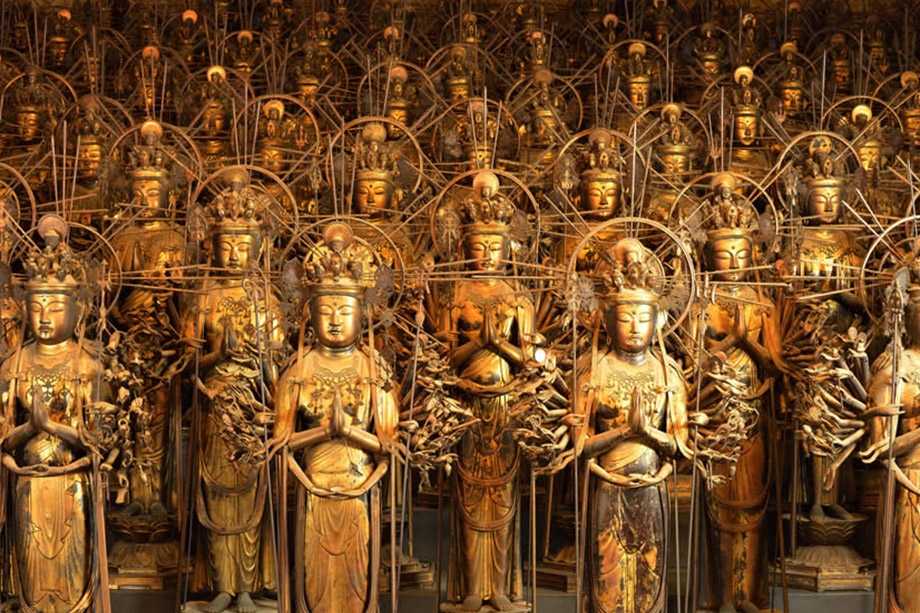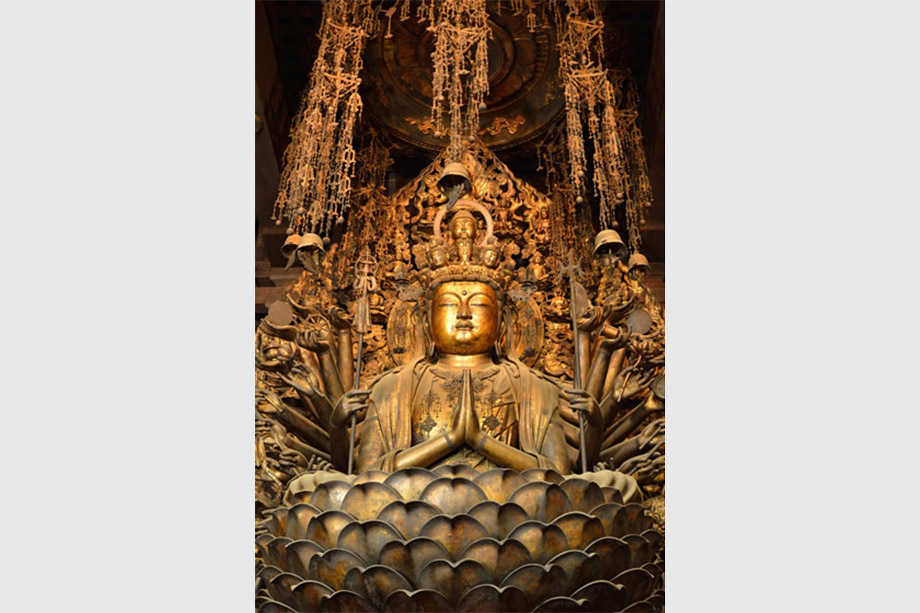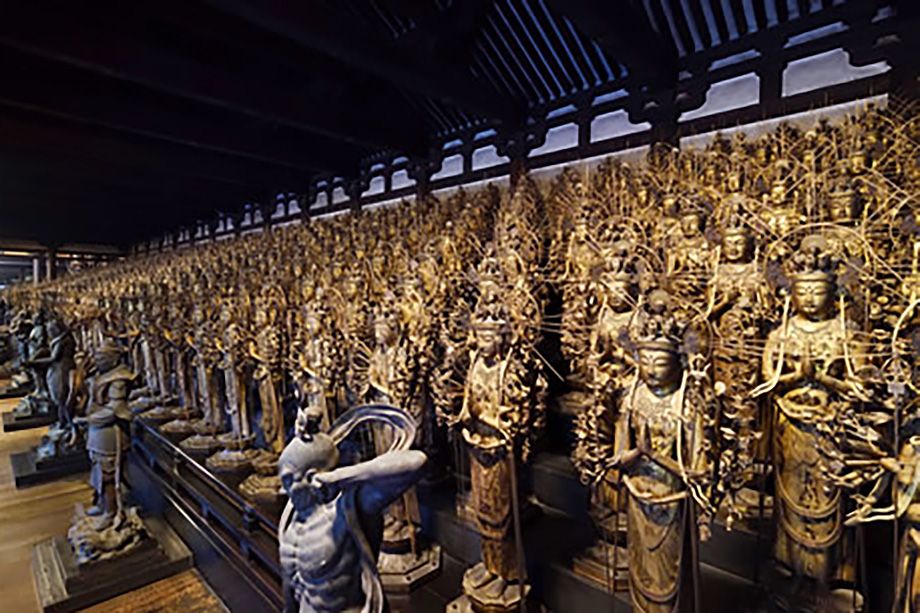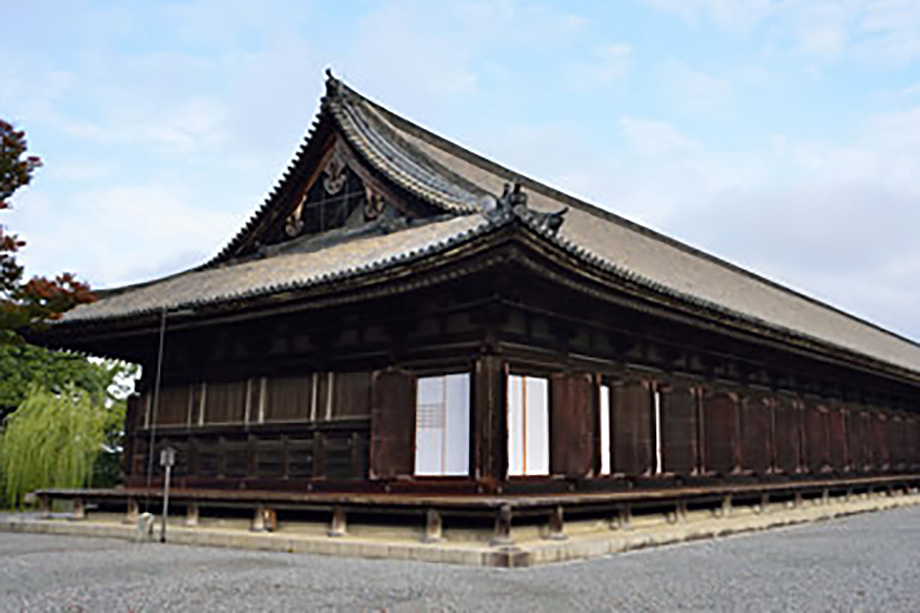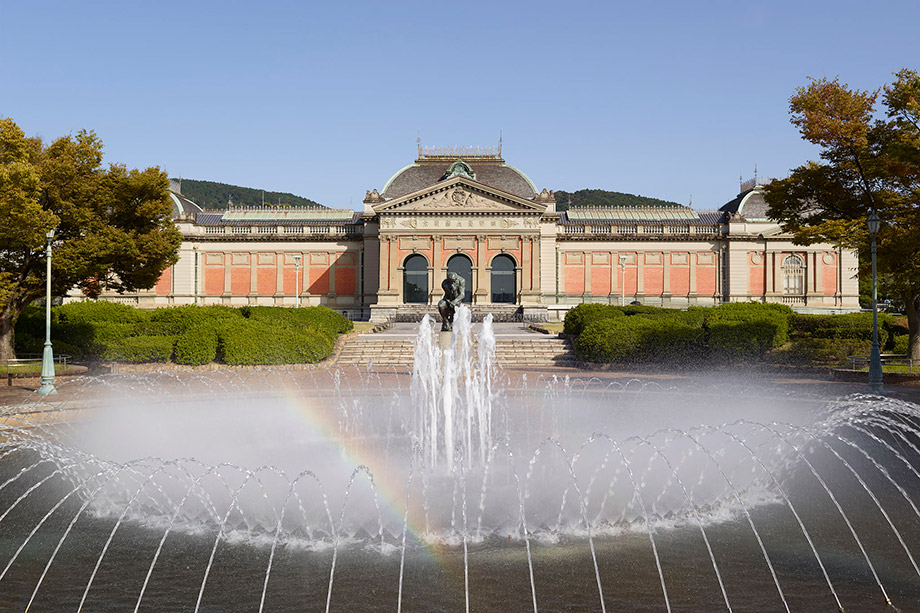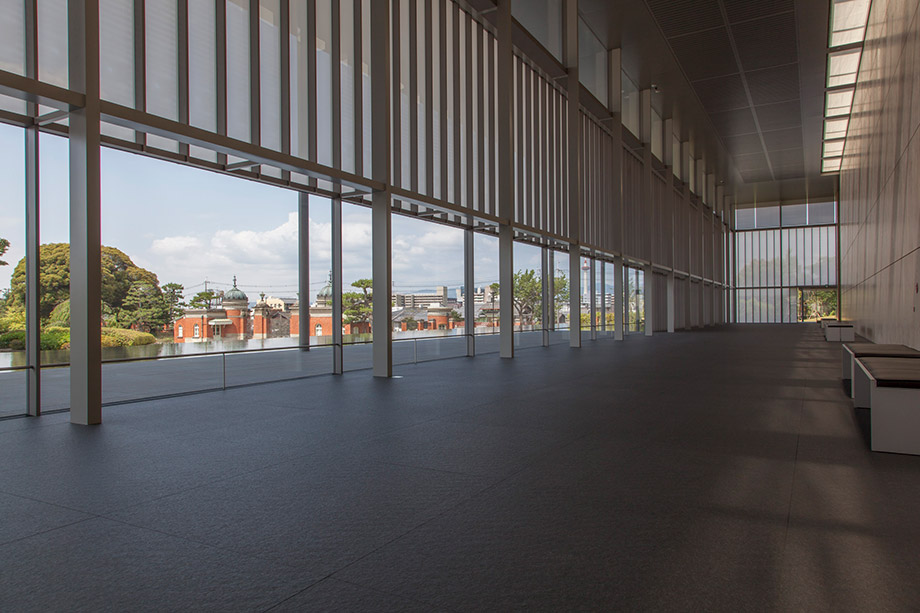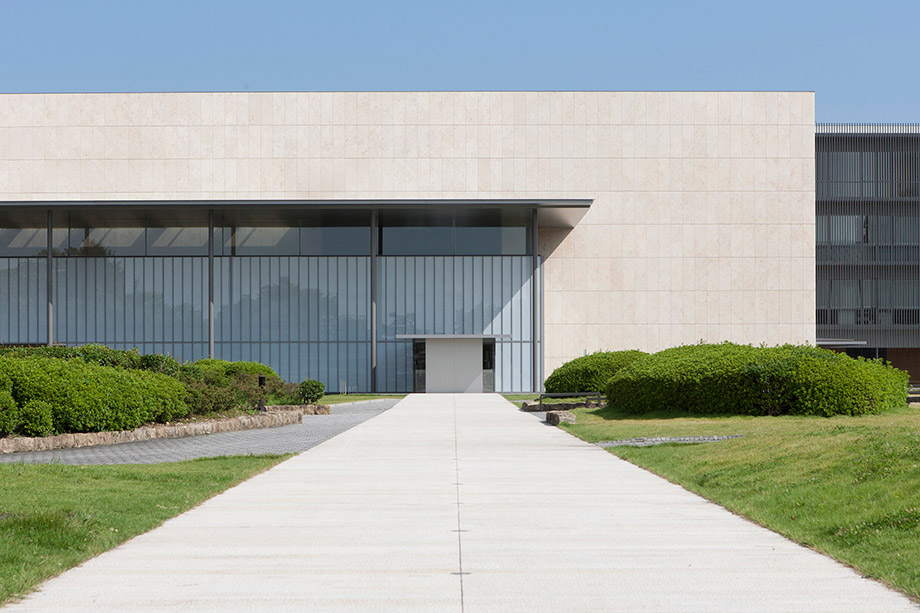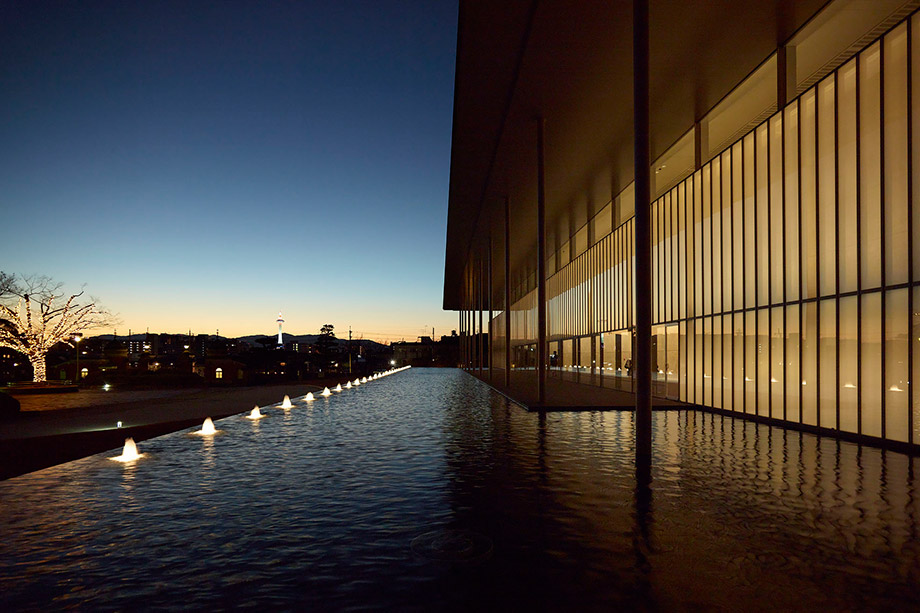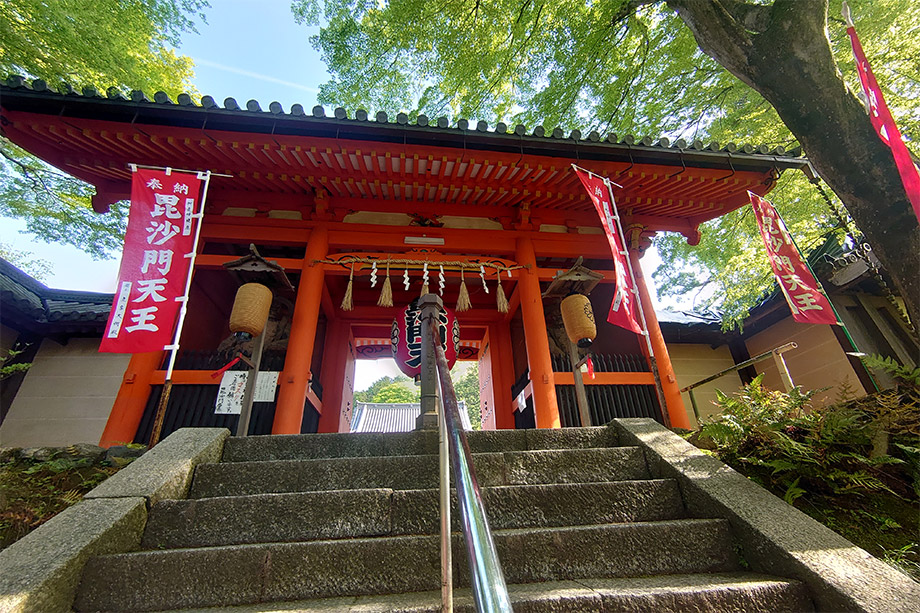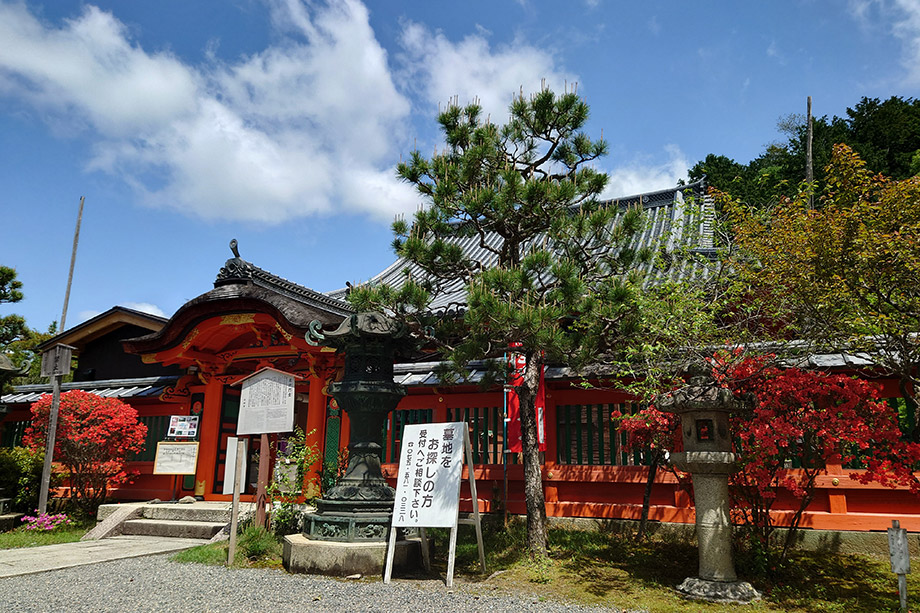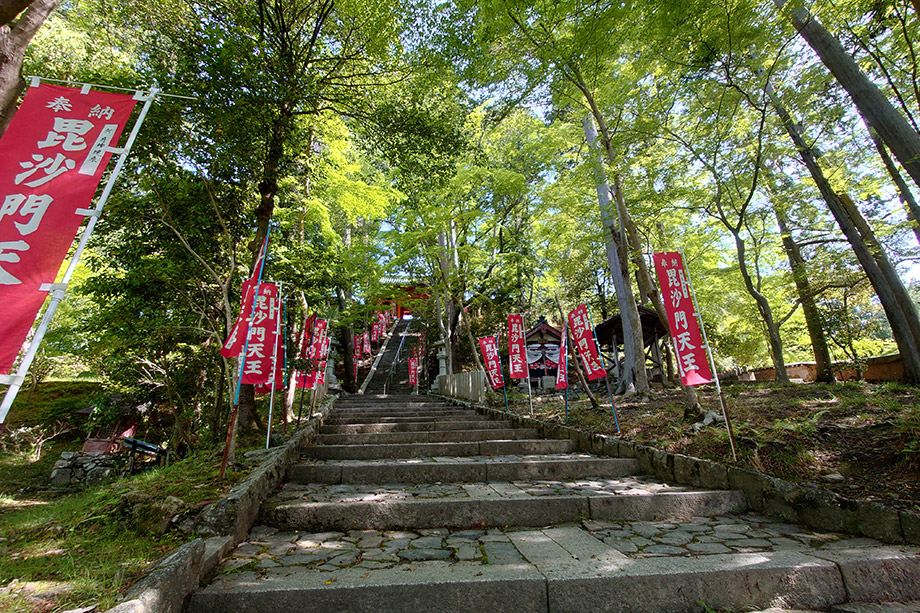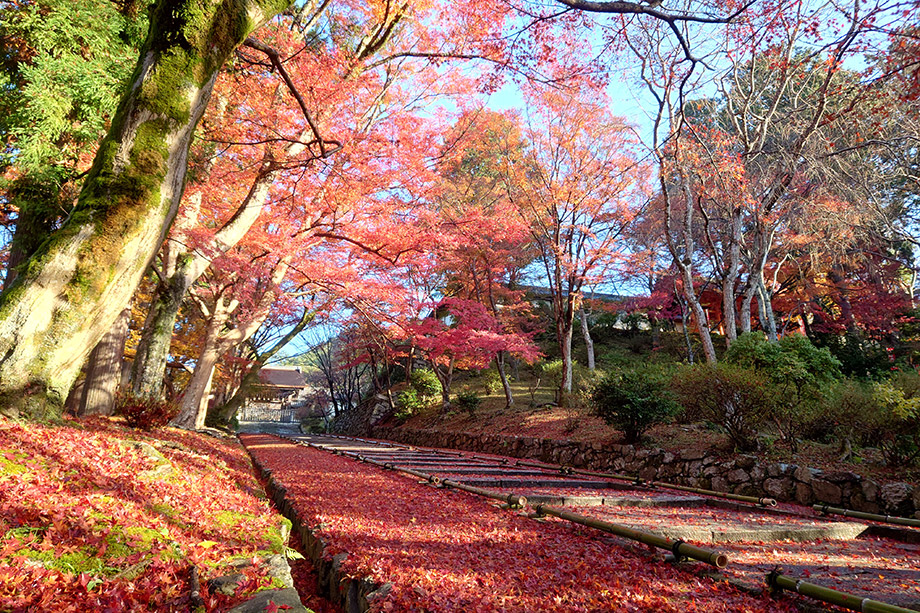
- Tetsugaku No Michi (The Philosopher's Walk)
- Honen-in Temple
- Heian Jingu Shrine
- Kyoto City KYOCERA Museum of Art
- Kyoto City Zoo
- National Scenic Beauty Murin-an
- Eikan-do Temple
- Nanzen-ji Temple
- Chion-in Temple
- Yasaka-jinja Shrine
- Kodai-ji Temple
- Ninen-Zaka and Sannen-Zaka
- Kiyomizu-dera Temple
- Yasaka Koshindo Temple
- Hanami-koji Street
- Kenninji Temple
- Kamo River
- Shirakawa River in Gion
- Nishiki Market
- House of Kawai Kanjiro – Museum
- Sanjusangen-do Temple (Rengeo-in Temple)
- Kyoto National Museum
- Bishamon-do Temple
-
Tetsugaku No Michi (The Philosopher's Walk)
Located between Ginkakuji Temple and Kumano Nyakuoji Shrine, this 2-km walking path was named after early 20th century philosopher and Kyoto University professor Kitaro Nishida, who used to take a stroll along this path every morning to meditate. It is famous for its cherry blossoms.
-
Honen-in Temple
This old temple is located in a tranquil setting next to a promenade known as the Philosopher's Walk which was created aside a canal. When you climb the stone-paved approach, the thatched San-mon Gate greets you with mountain village charm. In early spring, a wide variety of camellias, including the goshiki-chiri (falling in five colors) camellia, come into bloom so that the temple is sometimes called Camellia Temple. In fall, many people who know Kyoto well come to see the leaves that have fallen on the roof of the simple San-mon Gate.
- Address:
- 30 Shikagatani Gosho Dan-cho, Sakyo-ku, Kyoto, Kyoto Prefecture
- Hours:
- 6:00 a.m. to 4:00 p.m.
- URL:
http://www.honen-in.jp/ – Japanese
-
Heian Jingu Shrine
Heian Jingu Shrine was built in 1895 to commemorate the 1100th anniversary of the founding of the Heian capital in Kyoto. The attractive main building is a reproduction of the Outer Palace Precincts of the Heian capital and Oten-mon Gate on an five-eighth scale, and gives a realistic feel for the size of the capital at the time. Heian Shrine is also known as the location for Jidai Matsuri, one of the three great festivals of Kyoto.The festival procession recreates Kyoto's history with elegance, the participants dressing themselves in beautiful clothing from the past.
- Address:
- 97 Okazaki Nishitenno-cho, Sakyo-ku, Kyoto, Kyoto Prefecture
- Hours:
- 6:00 a.m. to 6:00 p.m. (Shin-en Garden: 8:30 a.m. to 5:30 p.m.)
*Please note that the schedule is subject to change according to season. Please check the website.
-
Kyoto City KYOCERA Museum of Art
The Museum originally opened in 1933 as the Kyoto Enthronement Memorial Museum of Art in Kyoto's Okazaki district. After World War II, it was renamed the Kyoto Municipal Museum of Art. As Japan's oldest public art museum housed in its original architecture, it had been highly appreciated for over 85 years. For the Museum Renewal Project in 2020, innovative concepts incorporating new designs while preserving original elements were introduced by Aoki Jun and Nishizawa Tezzo, two leading Japanese architects. The plan allowed for a fresh image of the Museum through the fusion of traditional and new elements. We invite you to enjoy the new Kyoto City KYOCERA Museum of Art.
- Address:
- 124 Okazaki Ensyoji-cho, Sakyo-ku, Kyoto, Kyoto Prefecture
- Hours:
- 10:00 a.m. to 6:00 p.m. (last entry: 5:30 p.m.)
- Closed:
- Mondays (except public holidays), Year-end/New Year holidays (December 28th to January 2th)
-
Kyoto City Zoo
Opened in 1903, it is the second oldest zoo in Japan, and its easy-to-understand exhibits that allow visitors to learn about the lives of animals are very popular. The zoo consists of six zones, including "Fierce Animals World," "African Grassland," "Elephant Forest," and other interesting zones. The main entrance has a café and restaurant open to the general public without requiring admission to the zoo.
- Address:
- Okazaki Hosyoji-cho, Sakyo-ku, Kyoto, Kyoto Prefecture
- Hours:
- March to November: 9:00 a.m. to 5:00 p.m.
December to February: 9:00 a.m. to 4:30 p.m.
*Last entry is 30 minutes before closing.
- Closed:
- Mondays (Tuesday if a holiday falls on a Monday)
-
National Scenic Beauty Murin-an
Built between 1894 and 1895, this was the villa of politician Yamagata Aritomo. The garden is a masterpiece of modern Japanese landscaping, created by Jihei Ogawa the VII based on the directions received by the owner, Yamagata Aritomo. It is the only place among the villas in the Nanzenji Temple area that is open to the public all year round. It was designated a National Scenic Beauty in 1951.
- Address:
- 31 Nanzenji Kusagawa-cho, Sakyo-ku, Kyoto, Kyoto Prefecture
- Hours:
- April to September: 9:00 a.m. to 6:00 p.m.
October to March: 9:00 a.m. to 5:00 p.m.
*Last entry is 30 minutes before closing.
-
Eikan-do Temple
The tree colors of autumn are so prominent here, Eikan-do Temple has been synonymous with autumn leaf viewing since days of yore. There are some three thousand maples on the grounds, which are lit up at night during the autumn viewing season. The temple grounds are on a mountain slope, and one never tires of walking around the extensive area or going up and down the corridors. Even in years when the fall leaves do not reach their full potential, the trees here are praised for their remarkable beauty.
- Address:
- 48 Eikando-cho, Sakyo-ku, Kyoto, Kyoto Prefecture
- Hours:
- 9:00 a.m. to 5:00 p.m. (last entry: 4:00 p.m.)
-
Nanzen-ji Temple
Nanzen-ji Temple is the top-ranking Zen temple in Kyoto. San-mon Gate, a substantial structure rising 22 meters can be climbed to look out over the city of Kyoto. In the kabuki production "San-mon Gosan no Kiri" (The Golden Gate and the Paulownia Crest), Ishikawa Goemon climbs the gate and says, "A magnificent view! A magnificent view!" This scene is well-known to Japanese people. Outside the abbot's chamber, a National Treasure, there is a dry landscape garden that portrays the scene of a mother and child tiger crossing a river. Inside the chamber are more than 130 exceptional fusuma paintings in the Kano tradition, a truly impressive collection.
- Address:
- Nanzenji Fukuchi-cho, Sakyo-ku, Kyoto, Kyoto Prefecture
- Hours:
- December to February: 8:40 a.m. to 4:30 p.m.
March to November: 8:40 a.m. to 5:00 p.m.
*Last entry is 20 minutes before the end of the visit.
- URL:
https://www.nanzenji.or.jp/ – Japanese
-
Chion-in Temple
Chion-in Temple is the first location where chanting "Namu Amida Butsu," the name of Amitabha, was taught by the monk Honen as a way anyone could be saved. After the temple became a family temple for the shogun in the Edo period, massive structures were built one after the other. Among these is San-mon Gate, a National Treasure. With a height of 24 meters and a width of 50 meters, this gate is one of the largest two-story wooden gates currently in existence.
- Address:
- 400 Rinka-cho, Higashiyama-ku, Kyoto, Kyoto Prefecture
- Hours:
- 9:00 a.m. to 4:00 p.m. (last entry: 3:50 p.m.)
-
Yasaka-jinja Shrine
According to tradition, Yasaka-jinja Shrine was built in the year 656, about 150 years before Kyoto became Japan's capital. Gion Festival, one of the three great festivals of Japan, originated in the year 869 when an epidemic spread. Sixty-six halberds were erected on the grounds of Yasaka Shrine and portable shrines were taken out and paraded to pray for an end of the disease.
- Address:
- 625 Gion-machi Kitagawa, Higashiyama-ku, Kyoto, Kyoto Prefecture
- Hours:
- 9:00 a.m. to 5:00 p.m.
-
Kodai-ji Temple
Kodai-ji was built in 1606 by the widow of Toyotomi Hideyoshi (often known by the title Kita no Mandokoro) to honor the soul of her late husband. Toyotomi Hideyoshi is the second warlord to successfully unify Japan. The special mausoleum enshrines Hideyoshi and Kita no Mandokoro. The room interiors feature impressive gold-lacquered art that is famous in Japan. Several of the temple buildings are designated as Important Cultural Properties of Japan.
- Address:
- 526 Kodai-ji, Shimokawara-cho, Higashiyama-ku, Kyoto
- Hours:
- 9:00 a.m. to 5:30 p.m. (last entry: 5:00 p.m.)
-
Ninen-Zaka and Sannen-Zaka
The areas near Kiyomizu-dera Temple known as Ninen-zaka and Sannen-zaka are together designated as an Important Preservation District for Groups of Traditional Buildings. The old buildings and street paved with flagstones make for an excellent stroll to enjoy the atmosphere of the old capital. With souvenir shops and restaurants along the way, Ninen-zaka and Sannen-zaka are always filled with many tourists.
- Address:
- 2 Kiyomizu, Masuyama-cho , Higashiyama-ku, Kyoto
-
Kiyomizu-dera Temple
A UNESCO World Heritage Site. The main building, generally referred to as the "Kiyomizu stage," was rebuilt in 1633. Rising 13 meters, the Kiyomizu-dera stage was built of wood without the use of a single nail. In Japan, the expression "jump off the stage of Kiyomizu" is equivalent to the English "take the plunge" when doing something with absolute resolve.
- Address:
- 1-294 Kiyomizu, Higashiyama-ku, Kyoto, Kyoto Prefecture
- Hours:
- 6:00 a.m. to 6:00 p.m.
*The gate closes at 6:30 p.m. in July and August.
-
Yasaka Koshindo Temple
Founded in 960, it is officially known as Daikokuzan Kongoji Koshindo Hall of the Tendai sect of Buddhism. It is also known as Yasaka Koshindo. Countless kukurizaru or "hanging monkey" talismans cover the site of the shrine. The kukurizaru symbolizes the Buddhist idea of controlling one's mind, which is inherited from the sutras of the Tendai sect of Buddhism, and is believed to grant wishes when offered to the main deity, Shomen Kongo.
- Address:
- 390 Kinen-cho, Higashiyama-ku, Kyoto, Kyoto Prefecture
- Hours:
- 9:00 a.m. to 5:00 p.m.
- URL:
http://www.yasakakousinndou.sakura.ne.jp/ – Japanese
-
Hanami-koji Street
The Gion area is filled with teahouses and restaurants built in the machiya style. At certain times of the day, geisha and maiko can be seen heading to their engagements. The unique atmosphere of Gion is particularly strong along Hanami-koji Street and the Shirakawa River.
- Address:
- Gion, Higashiyama-ku, Kyoto
-
Kenninji Temple
Founded in 1202, it is Kyoto's oldest Zen temple. Visitors have the opportunity to view the "Fujin and Raijin" screens by Tawaraya Sotatsu which are designated as National Treasures (the display is a reproduction), and three gardens with different atmospheres. The Dharma Hall features a ceiling painting called "Twin Dragons" by Koizumi Junsaku which covers an area of 108 tatami mats (approx. 11.4 m by 15.7 m).
- Address:
- 584 Komatsu-cho, Higashiyama-ku, Kyoto, Kyoto Prefecture
- Hours:
- 10:00 a.m. to 5:00 p.m. (last entry: 4:30 p.m.)
- URL:
https://www.kenninji.jp/ – Japanese
-
Kamo River
The Kamo River is one of the most famous rivers in Kyoto. People can always be seen strolling along the banks of the Kamo River, enjoying their hobbies and interests. In summer, riverside restaurants set up "kawadoko" (riverbeds) for people to cool off.
-
Shirakawa River in Gion
This is a typical Kyoto scenic spot with its rows of machiya (townhouses), the Shirakawa River that flows by and the cobblestone streets. With luck, visitors may even see a maiko (apprentice geisha). It is also a famous spot for viewing cherry blossoms, and is a must-see stop for tourists visiting Kyoto in the spring.
-
Nishiki Market
Called "Kyoto's kitchen," Nishiki Market is a bustling area in the Shijo area of Kyoto, crammed with shops on both sides of the narrow street selling meats, vegetables and other fresh foods, along with a wide range of other daily necessities. The market is filled with energy all day long. Nishiki Market is frequented by professional chefs and locals in addition to the large number of tourists.
- Address:
- Nishiki Koji-dori Tera-machi Nishi-iru or Nishiki Koji-dori Takakura Higashi-iru, Nakagyo-ku, Kyoto
-
House of Kawai Kanjiro – Museum
The house, workshop, and pottery kiln of Kawai Kanjiro, a ceramic artist and leading figure in the Mingei (Japanese folk art) movement, are now open to the public as a commemorative museum. The building, which was designed by Kawai himself, is filled with furniture and fixtures designed by Kawai himself, and offers visitors a glimpse into the spiritual world of Kawai, as well as his lifestyle.
- Address:
- 569 Gojo-zaka Kanei-cho, Higashiyama-ku, Kyoto, Kyoto Prefecture
- Hours:
- 10:00 a.m. to 5:00 p.m. (last entry: 4:30 p.m.)
- URL:
http://www.kanjiro.jp/ – Japanese
-
Sanjusangen-do Temple (Rengeo-in Temple)
The main hall of this temple, which extends 120 m (393.7 ft) north-to-south, with a depth of 22 m (72.2 ft), contains one seated figure of Senju-Kannon (a Buddhist saint of infinite mercy, who grants people salvation with her one thousand arms and eyes) measuring jo-roku (4.8 m / 15.7 ft) in height created by Buddhist sculptor Tankei, and rows of 1000 life-sized standing figures of Senju-Kannon (created in the 12th to 13th centuries). The spectacle of these statues, surrounded by statues of the wind god, Fujin, and the thunder god, Raijin, and the Nijuhachibushu (28 gods who protect the believers of Kannon) is simply overwhelming. All the Buddhist figures in the hall (1,032 of them) have been designated National Treasures.
- Address:
- 657 Sanjusangen-do, Umawari-cho, Higashiyama-ku, Kyoto, Kyoto Prefecture
- Hours:
- 8:30 a.m. to 5:00 p.m.
*9:00 a.m. to 4:00 p.m. between Mid-November and March.
*Last entry is 30 minutes before closing.
- URL:
http://sanjusangendo.jp/ – Japanese
-
Kyoto National Museum
The museum opened in 1897 under the name of Imperial Museum of Kyoto. The Meiji Kotokan Hall, built of brick and designed by court architect Katayama Toguma, is designated as an Important Cultural Property. The Heisei Chishinkan Hall exhibits art works and cultural properties in a variety of fields, including archaeology, ceramics, sculpture, painting, calligraphy, textiles, lacquerware, and metalwork, from the museum's collection of approximately 14,600 pieces, which includes both the museum's own collection and items on loan from other museums. The museum also holds special exhibitions several times a year.
- Address:
- 527 Chaya-cho, Higashiyama-ku, Kyoto, Kyoto Prefecture
- Hours:
- 9:30 a.m. to 5:00 p.m. (last entry: 4:30 p.m.)
-
Bishamon-do Temple
Although the proper name is Goho-ji, this temple gets its popular name from its dedication to Bishamonten, one of the Seven Gods of Fortune of Kyoto. The main temple building, Kara Gate and Nio (Deva) Gate were constructed in 1666 with the same techniques as the World Heritage Site Nikko Tosho Shrine, and they feature ornate craftsmanship. Among the attractions is a fusuma painting in Shinden Hall that gives the impression of changing depending on the viewing angle, and one whose pattern combinations seem to be conveying a message to visitors.
- Address:
- 18 Anshu Inariyama-cho, Yamashina-ku, Kyoto, Kyoto Prefecture
- Hours:
- December to February: 9:00 a.m. to 4:30 p.m.
March to November: 9:00 a.m. to 5:00 p.m.
*Last entry is 30 minutes before the end of the visit.
